
We are somewhat surrounded by toxic chemicals today. Some of them we really don't have much control over, but they are having an effect on our health either way. I want to arm you with some information about what is hiding in common products found in your home that are you being exposed to daily that you CAN do something about!
I want to share reasons why you should consider trading out the toxins in commercial products.
Then, I will share some information about getting started in trading those items out, including why Young Living essential oils and other cleaning products are a great alternative.
The bulk of the class will be stories and recipes of how to clean our homes naturally.
So, let's get started....
No, I didn't design these cute little graphics. And yes, I wish I looked this good cleaning house :)

Whether or not you currently suffer from asthma, it’s important to understand the respiratory risks associated with exposure to chemicals from cleaning supplies. For current asthma sufferers, various studies have linked exposure to chemicals from cleaning supplies (including “natural” fragrances) to worsening asthma symptoms and increased risk of asthma attacks. Many cleaning products, particularly air fresheners, may react with high levels of ozone from indoor sources or from outdoor air to form formaldehyde and dangerous fine particles indoors. Ozone is a harmful, but invisible, gas that worsens asthma and other lung diseases.
For those of you who are not currently asthma sufferers- take note. A growing body of evidence suggests that using cleaning products can also cause asthma to develop in healthy people. Studies have linked new cases of asthma to use of or exposure to spray cleaners, chlorine bleach sprays, disinfectants, air fresheners, drain cleaners, oven cleaners, furniture polish, carpet cleaners and floor waxing and stripping products.
And, if you’re pregnant, preliminary research findings also suggest that fetal exposure to household cleaning supplies may affect respiratory health of your child. Studies have identified that children born to women who frequently used cleaning supplies in their homes while pregnant had a higher risk of persistent wheezing and reduced lung function.
So… what can you do? Unfortunately, manufacturers are not obligated by US law to list all ingredients in consumer products, so reading labels may not always guarantee you know what you are getting in your cleaning products. Even cleaners labeled as “green” or “natural” do not necessarily mean they are safer since there is no regulation for these terms. The safest alternative is it use items you already have in your home, such as baking soda and vinegar. Essential Oils can provide a much needed boost to these cleaning powerhouses without the risk of harmful chemicals. We’ll talk more about this later, including recipes and Young Living products that you can use to clean your home and give you peace of mind.
(sources: Environmental Working Group, American Lung Association)
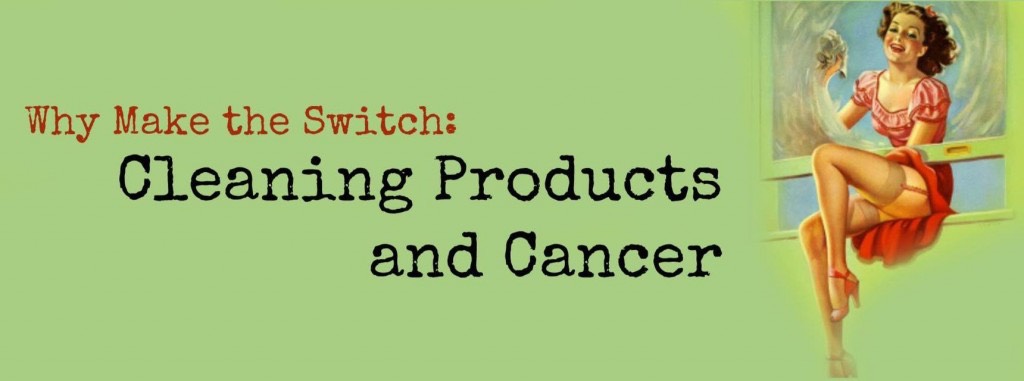
I think it is safe to say that we all know someone who has had to fight cancer. I think it is also safe to say that most of us realize there are carcinogenic ingredients in many common household cleaners. A retrospective study was done by the Silent Spring Institute. This study suggested there may be a link between common cleaners and cancer by following 1,500 women in Massachusetts, half of which had been diagnosed with breast cancer. This study found that the women who usedcleaning products more frequently were two times more likely to develop breast cancer than those who claimed to use the cleaning products less often.
Now let's take a minute to talk about two of the chemicals that the EWG found many household cleaners may be laced with that are possible, or probable, carcinogens.
-Formaldehyde, sometimes known as formalin, has been designated by both the U.S. Government and The World Health Organization as a known human carcinogen. Sometimes formaldehyde is not added to products, instead there are preservatives added that release formaldehyde in order to kill bacteria and also enhance shelf life of the product. A test done by the EWG on cleaning products in California schools found formaldehyde in Comet, Pine-Sol and Simply Green cleaning products.
-1,4-Dioxane is also a probable known carcinogen as classified by the EPA. This chemical is found in many liquid laundry detergents. Animals studies have found that animals exposed to 1,4-Dioxane have higher rates of liver tumors than animals that have not been exposed.
If this information is causing you to think twice about the cleaning products you use in your home, stick around, this class is perfect for you!
(Source: Environmental Working Group)

Are you pregnant or planning to become pregnant? If so, it is important to know that the chemicals used in common household cleaners can not only cause harm to you, but also to your unborn child. A survey done by the Environmental Working Group identified several specific chemicals that are known or suspected reproductive toxins. These findings include the following:
Diethylene glycol monomethyl ether (DEGME) which is found in degreasers and heavy duty cleaners. This chemical has essentially been banned by the European Union as it is suspected of damaging fertility and also the developing fetus. Women who had been exposed to this chemical while working were found to be more likely to give birth to babies with birth defects.
Think this only pertains to women? Think again! Men who were exposed to the chemicals while working were also found to have a reduced sperm count.
Borax and boric acid is considered by the European Union to be toxic to the reproductive system. Animal studies done on these chemicals have shown that they do cross the placenta and may cause low birth weight and affect fetal skeletal development.
Once again, this isn't only a problem for pregnant women. Men who were exposed to the chemicals were also found to be at greater risk for low sperm count along with decreased libido.
The New York State Department of Health conducted a study in 2010 found that children born to women working with chemical cleaners as custodians were at greater risk for certain congenital deformities. Other studies have found that some children had lower IQ's and reduced language skills when their mothers had been exposed to organic cleaners while pregnant.
So what can you do? Ditch those toxic chemical cleaners. Not sure how? Stick around, we are more than happy to help you!
(Source: Environmental Working Group)
Exposure to phthalates, bisphenol A and metals in pregnancy
Environmental Toxins Found in Newborns' Cord Blood
Why is it so important to get rid of endocrine disruptors?
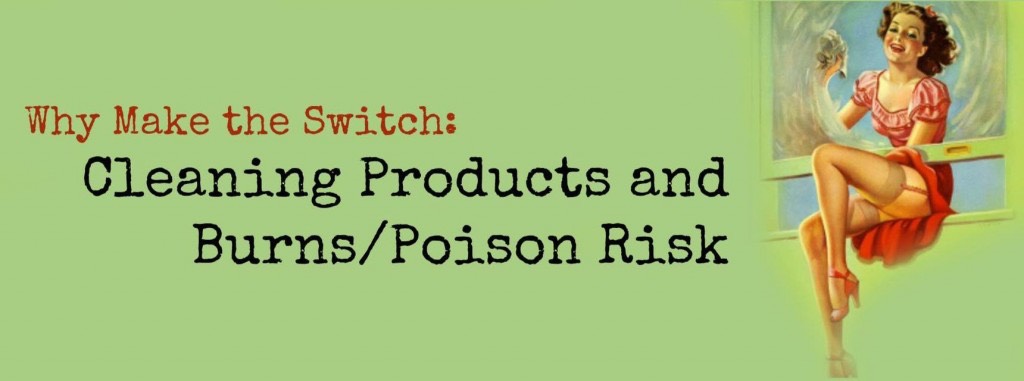
Did you know that everyday there are accidents involving household cleaners? Severe damage can be cause by cleaners when contact is made with the skin, eyes, or when cleaners are ingested.
What's worse is when these accidents involve children. In 2010 alone there were more than 116,000 calls to poison control centers in America that involved household cleaners and children age 5 and under.
In 2006, according to emergency room records, there were 10,318 children younger than 5 who received treatment because of accidents with cleaners. Of those 10,318; 744 were treated for symptoms that could have resulted in severe disability or even death.
The Environmental Working Group states 'there are safer cleaning products on the market that do not risk lasting damage to small explorers.' We can definitely agree with that statement.
Chemical free cleaning is one of the reasons, personally, that I fell in love with Young Living products. I think many others are able to say the same thing.
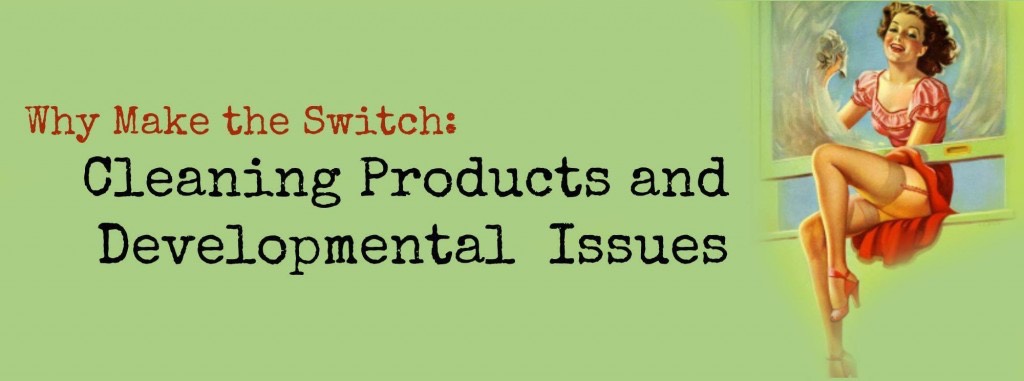
Have you considered the impact the chemicals and toxins in your home could have on developmental issues? Children in particular are experiencing increased developmental issues. One thing that has changed dramatically over the last several decades is human exposure to toxic chemicals and metals in the environment. Many of these chemicals and metals are known to affect the developing fetal brain which is highly sensitive during the first three months of growth.
In children who are susceptible, exposure to a neurotoxic metal or chemical during this window could confer a lasting change in brain structure and function.
'According to a review article by Philip J. Landrigan of the Children's Environmental Health Center at the Mount Sinai School of Medicine published in the January, 2010 issue of Current Opinion in Pediatrics. Children are exposed to roughly 3,000 chemicals in personal care products, building materials, cleaning products and motor vehicle fuels, yet fewer than 20 percent of these chemicals have been tested thoroughly to see if they harm the developing brain. "We've created a situation where we are exposing our children and grandchildren every day to new chemicals that didn't exist [until recently]," says Landrigan. "We've never tested them, and we don't have a clue what these chemicals do to early development." '
(Sources: Natural Resources Defense Council)
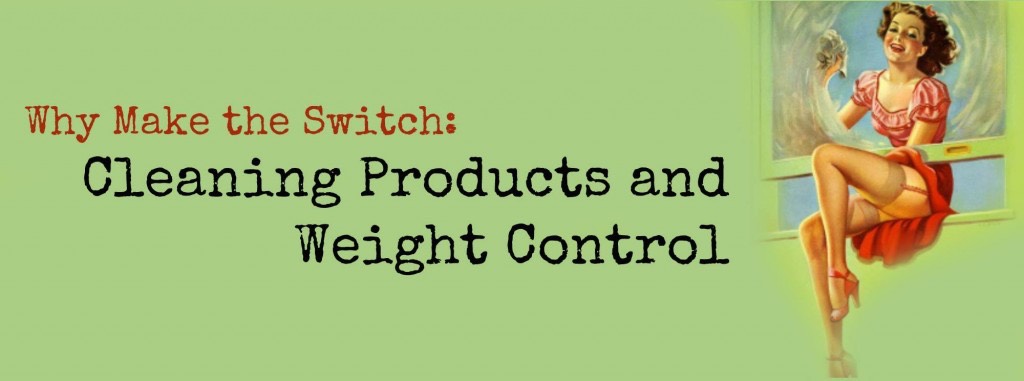
Obesity plagues America, right? No judgement here... I am among those that struggle with weight issues.
You've tried dieting, but you just gain it all back (with maybe a little more). You've tried exercising, but lack of energy and plateaued or waning results disheartened you and shed away your motivation to continue. I've been there. Diet has always been a four letter word in my book, simply because it has always lead to disappointment and an even lower self-esteem (its bad enough being fat, but I have to lack willpower and fortitude, too? dang!).
Consider this: you are fighting an uphill battle... not only against food cravings, a busy schedule, expensive foods, and all the rest that make healthy weight control a challenge. You are fighting an uphill battle against toxic chemicals.
Your body uses fat as a defense system against toxic chemicals in the body. Instead of letting them travel around the body, wreaking havoc in all of your major body systems, it puts it in jail. Fat jail. It surrounds those toxins in little bubbles of adipose tissue.
And you know that other not-four-letter-word-but-should-be things we all love (100% sarcasm), cellulite? Those curdy, bumpy bubbles of anti-sex appeal come next. The number one factor in cellulite? You guessed it: toxin build-up. See the visual in the comments to learn what this is and why it happens.
Fast forward to diet and exercise: You cut calories (often with chemical-ridden low fat and sugar free food choices), you hit the treadmill hard, you are feeling and seeing the burn! As you burn your fat store, your body weight to toxin ratio goes down. In other words, your toxin to body weight ratio goes up. Way up. So your body goes back into defense mode. It will buckle down, become ultra efficient in energy usage, and manage to operate on less calories so that it can protect itself by encapsulating those toxins. The tangible result... the infamous rebound.
It all makes sense now, doesn't it? Your light bulb just lit up.
So what do you do? It feels like you can't win, right? Wrong! Give toxins the boot. This includes a few vital steps:
1. Cleanse/detox. In order to get those toxins out, we need to do a cleanse and detox to help our bodies break down those toxins and flush them out of our bodies. I'm not going to talk too much about this today, but check out Young Living's 5-Day Nutritive Cleanse if you are looking for a head start. There are also some very gentle fruit and veggie cleanses out there. Don't forget to use organic, non-GMO produce so you aren't ingesting even more chemicals. It is great practice to do a cleanse 2-4 times per year.
2. Minimize Future Exposure. Get rid of as many of the toxins around you as possible. This includes cleaning products, which we are discussing this class, as well as other toxic products in your personal care regimen and even your diet. If it ain't natural, minimize it. If it is natural, make sure it was grown and harvested responsibly, without the use of toxic pesticides, herbicides, fertilizers, etc.
Feeling empowered to get healthy? Aww yea!
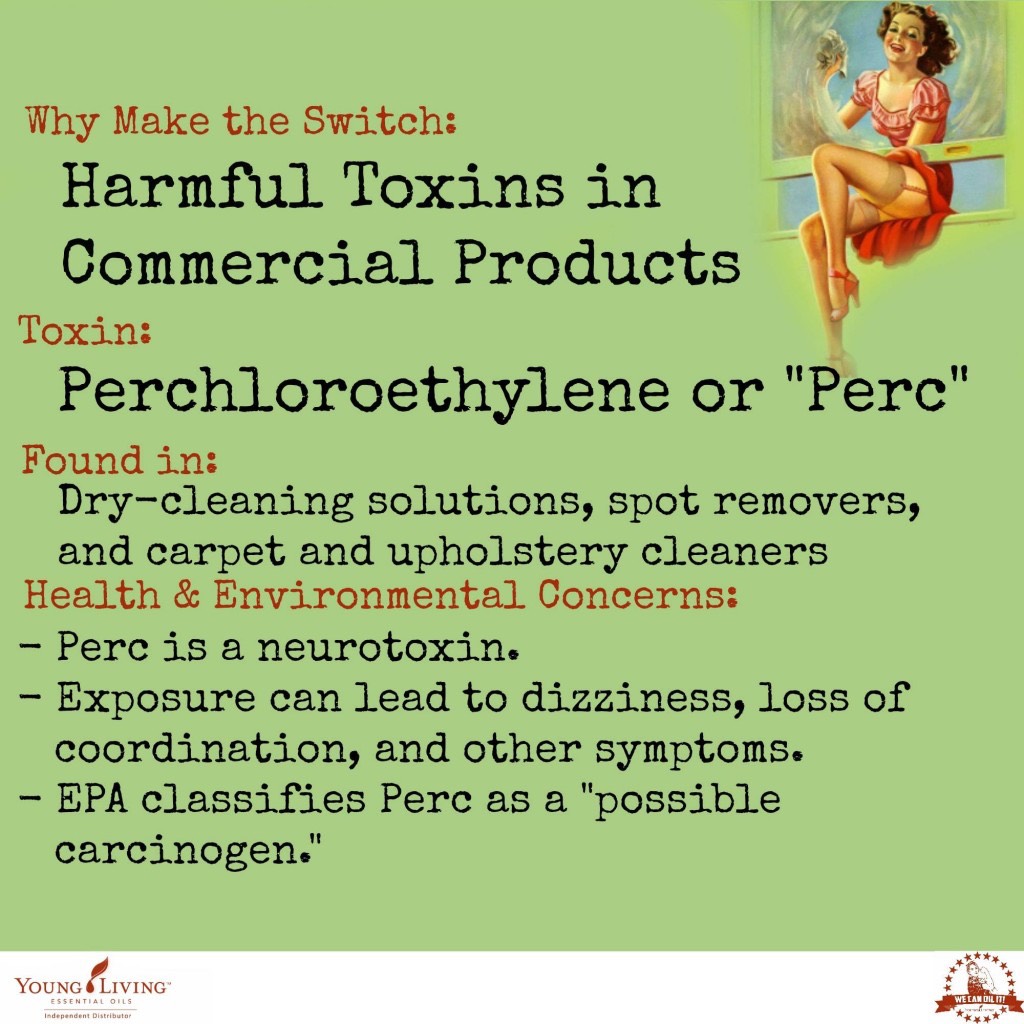
Tetrachloroethylene (AKA Perchloroethylene or "Perc") is widely used for dry-cleaning fabrics and metal degreasing operations. Effects resulting from acute (short term) high-level inhalation exposure of humans to tetrachloroethylene include irritation of the upper respiratory tract and eyes, kidney dysfunction, and neurological effects such as reversible mood and behavioral changes, impairment of coordination, dizziness, headache, sleepiness, and unconsciousness. The primary effects from chronic (long term) inhalation exposure are neurological, including impaired cognitive and motor neurobehavioral performance. Tetrachloroethylene exposure may also cause adverse effects in the kidney, liver, immune system and hematologic system, and on development and reproduction. Studies of people exposed in the workplace have found associations with several types of cancer including bladder cancer, non-Hodgkin lymphoma, multiple myeloma. EPA has classified tetrachloroethylene as likely to be carcinogenic to humans.

Found in: Window, kitchen and multipurpose cleaners.
Health Risks: 2-butoxyethanol is the key ingredient in many window cleaners and gives them their characteristic sweet smell. It belongs in the category of “glycol ethers,” a set of powerful solvents that don’t mess around. Law does not require 2-butoxyethanol to be listed on a product’s label. According to the EPA’s Web site, in addition to causing sore throats when inhaled, at high levels glycol ethers can also contribute to narcosis, pulmonary edema, and severe liver and kidney damage. Although the EPA sets a standard on 2-butoxyethanol for workplace safety, Sutton warns, “If you’re cleaning at home in a confined area, like an unventilated bathroom, you can actually end up getting 2-butoxyethanol in the air at levels that are higher than workplace safety standards.”
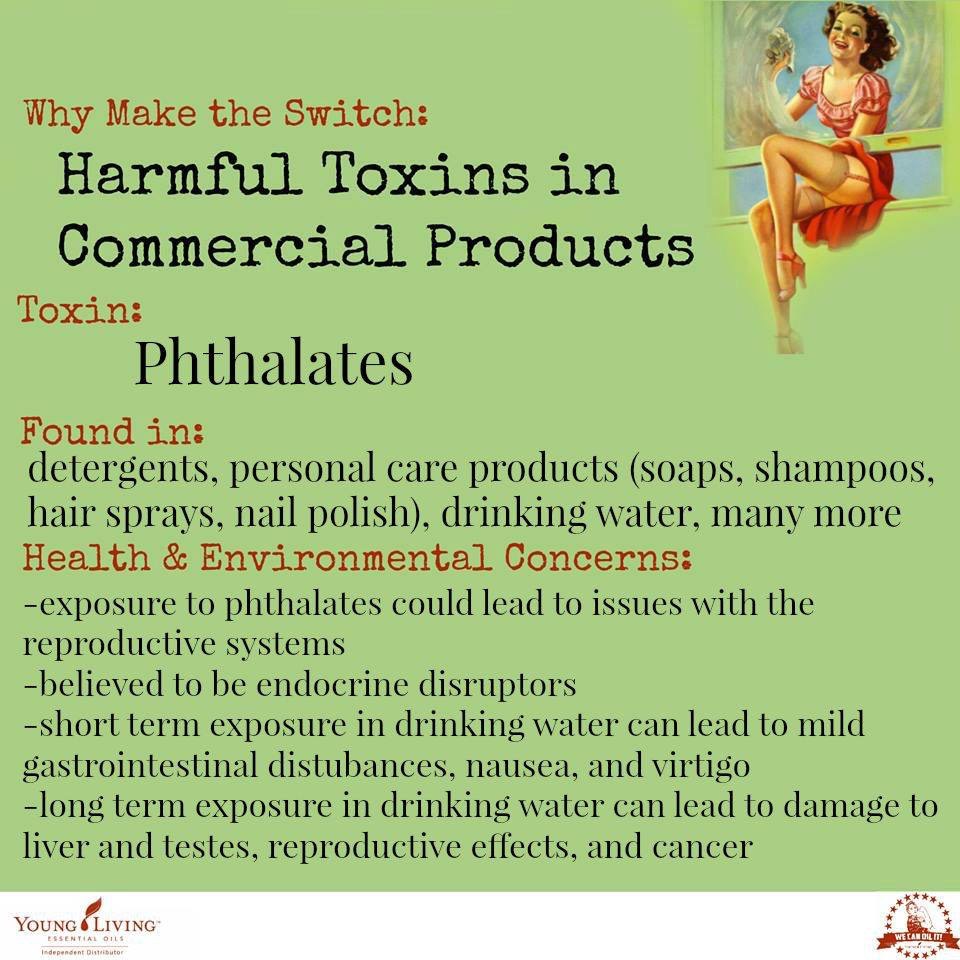
Think about the various ways your family is probably being exposed to THIS ONE!
According to the CDC, Phthalates are a group of chemicals used to make plastics more flexible and harder to break. Phthalates are used in hundreds of products including detergents, plastic clothes (such as raincoats), some children’s toys, and personal care products (soaps, shampoos, hair sprays, and nail polishes), just to name a few. Phthalates can also be found in drinking water.
People are exposed through the use of the products mentioned above, breathing in air/dust that contains phthalate vapors, and eating/drinking food stored in packaging containing phthalates. Children are at a greater risk of being exposed to phthalates because of their behavior of putting things, especially their own hands, into their mouths.
Research has led to the belief that phthalates can have an affect on the reproductive system and are suspected to be endocrine disruptors. The EPA found when looking at the affects of phthalates in drinking water that people exposed for a short period of time at levels above the maximum contaminant level (6 parts per billion) could have mild gastrointestinal disturbances, nausea, or vertigo. If exposed for long periods of time, a person may experience damage to the liver and testes, reproductive effects, or even cancer.
A study performed with over 2,600 participants found that adult women have higher levels of urinary metabolites than men for those phthalates that are used in personal care products.
*information obtained from the CDC website and sources cited on the CDC website.
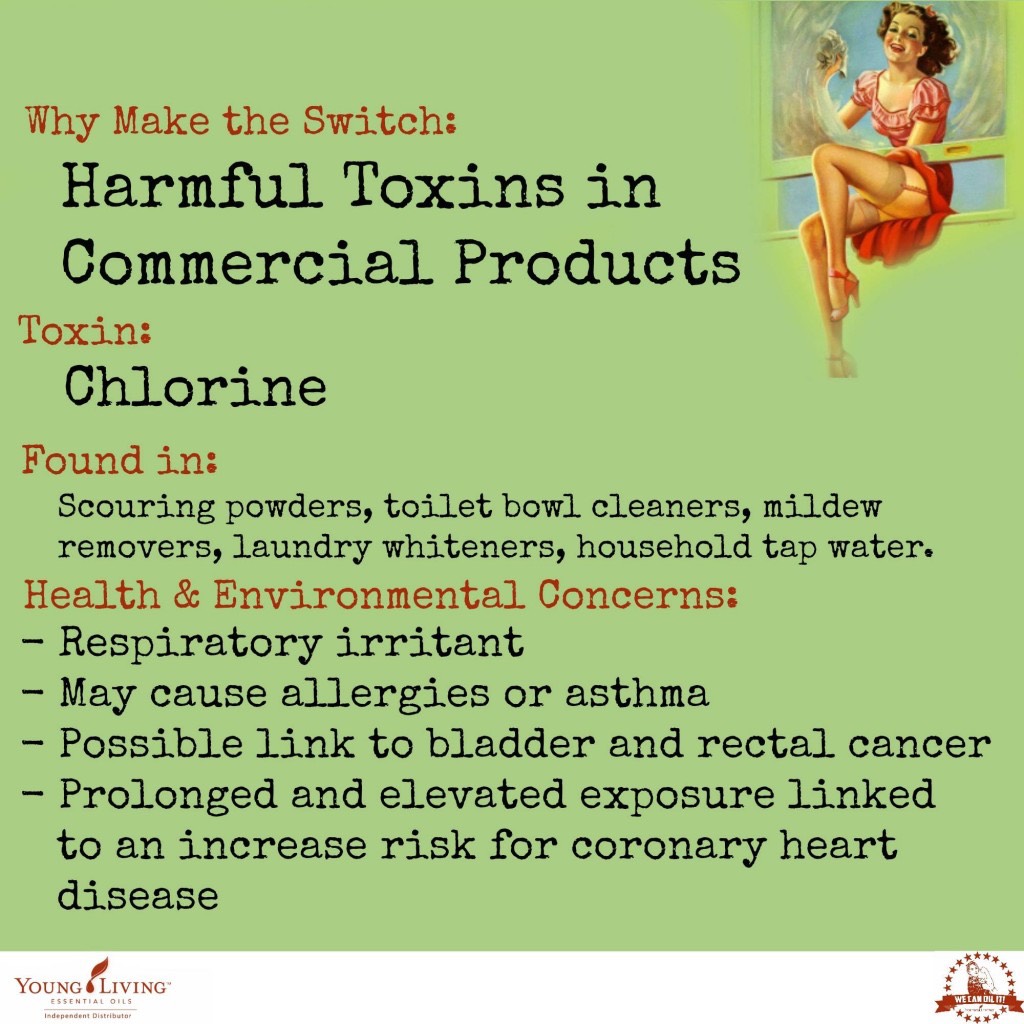
Chlorine is highly regarded as a health hazard. Chlorine is a naturally occurring element and, as part of the literal salt of the earth, very abundant. Humans have harnessed chlorine and most commonly use it for disinfecting purposes. Unfortunately, chlorine’s potential toxicity is not limited to mold and fungus and has actually been linked to serious health dangers for humans.
Chlorine is a strong oxidizing agent and irritant, harmful to eyes and skin, the respiratory passages and lungs.
Chlorine is in many household cleaners, it’s used as a fumigant, and, since it impedes the growth of bacteria like e. coli and giardia, and is often added to water systems as a disinfectant. Subsequently, much exposure happens by drinking treated tap water. While disinfection of drinking water is a necessary measure to reduce diseases, concerns have been raised about the safety of chlorine, which has been linked to serious adverse health effects, including dementia in elderly patients.
Millions of accidents and injuries happen every year in American homes, many of them involve exposure to toxic chemicals like bleach. Bleach can release chlorine gas and irritate the respiratory system if inhaled. If you’ve ever used this nasty stuff to clean a shower in a closed space, you have likely experienced the burn. Consider this, chlorine is toxic enough to be a chemical weapon and categorized as a “choking agent”. Inhalation of chlorine gas can cause difficulty breathing, chest pains, cough, eye irritation, increased heartbeat, rapid breathing, and death. Exposure would be a very traumatic experience.
In fact, the Dorn VA Medical Center in Columbia, South Carolina reported a chlorine spill accident that happened in South Carolina in January of 2005. Ten months after the event, exposure victims were still so shaken that many reported recurring PTSD symptoms.
Research suggests that children who are exposed to higher levels of chlorine may have increased risks of developing allergies or asthma. Among adults exposure to chlorine has been linked with other health problems including bladder and rectal cancer and, possibly, an increased risk for coronary heart disease.
The latest on this comes from a study in Belgium, which found that teens who spent more than 1,000 hours swimming in chlorinated pools had more than eight times the risk of developing asthma or allergies, compared to kids who usually swam in pools using a copper-silver disinfecting method. A total of 847 youngsters between 13 and 18 took part in the study - 114 of them mainly swam in pools disinfected with a copper-silver ion system. The number of kids who developed asthma increased in proportion to their exposure to chlorinated pools. Those who swam for 100 to 500 hours had almost twice the risk of developing asthma; while those who spent 500 to 1,000 hours had just over twice the risk; and asthma cases nearly quadrupled among those who spent more than 1,000 hours in chlorinated pools compared to teens who swam in non-chlorinated ones. The Belgian researchers also found that the risks of hay fever and other allergies more than doubled with significant exposure to chlorinated pools. The study was published in the online issue of Pediatrics on Sept. 14, 2009.
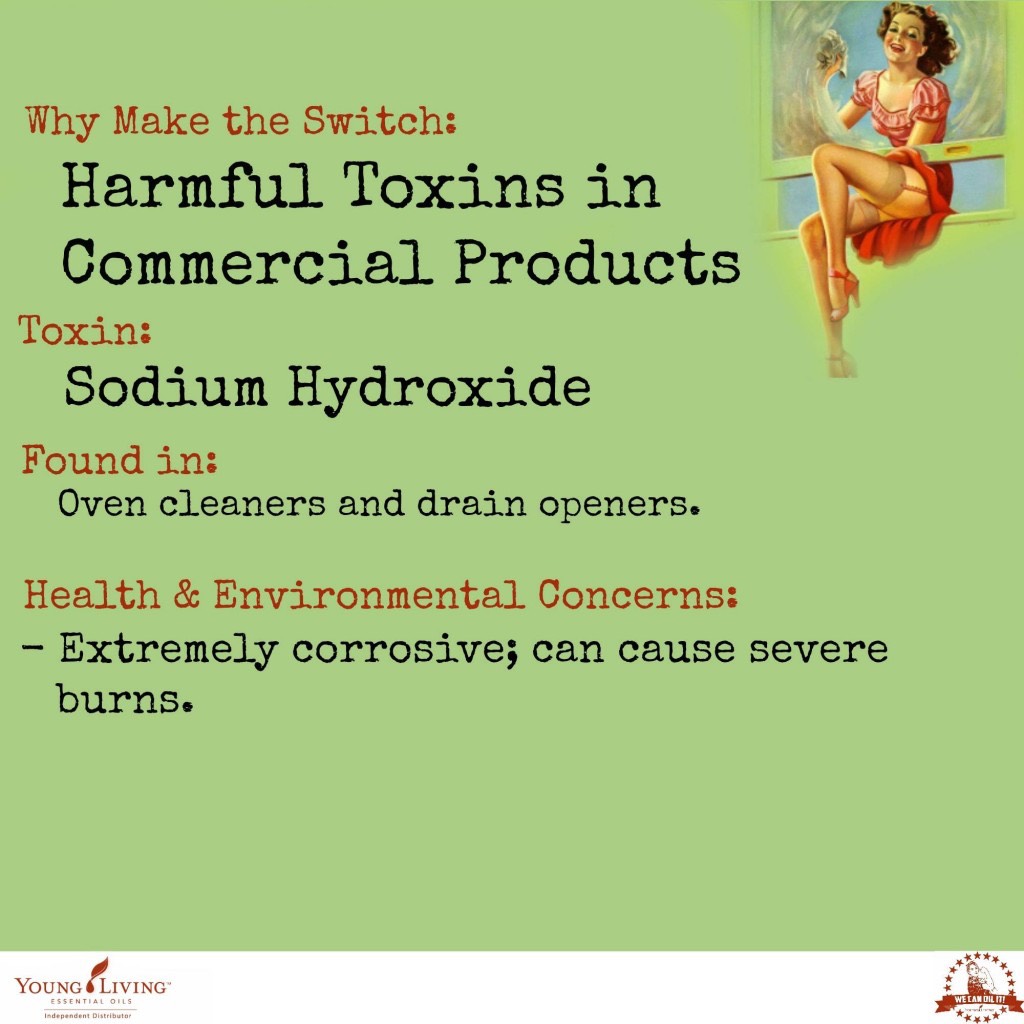
Sodium Hydroxide:Otherwise known as lye, Sodium Hydroxide makes our list due to its health concern upon immediate exposure. It is not tied to cancers, reproductive issues, or development issues. However, it is VERY corrosive and can cause serious injury.
It can cause severe burns and permanent damage to any tissue that it comes in contact with. Sodium hydroxide can cause hydrolysis of proteins, and hence can cause burns in the eyes which may lead to permanent eye damage. Inhaled sodium hydroxide can cause swelling of the larynx and an accumulation of fluid in the lungs. Stridor, vomiting, drooling, and abdominal pain are early symptoms of sodium hydroxide ingestion. Ingestion may lead to perforation of the gastrointestinal tract and shock.
Cancer of the esophagus has been reported 15 to 40 years after the formation of corrosion-induced strictures. However, it is believed that these cancers were the result of tissue destruction and scar formation rather than a direct cancer-causing action of sodium hydroxide.
Chronic exposure to dusts or mists of sodium hydroxide may lead to ulceration of the nasal passages. Chronic skin exposures can lead to dermatitis. Ingestion may lead to perforation of the gastrointestinal tract or stricture formation.
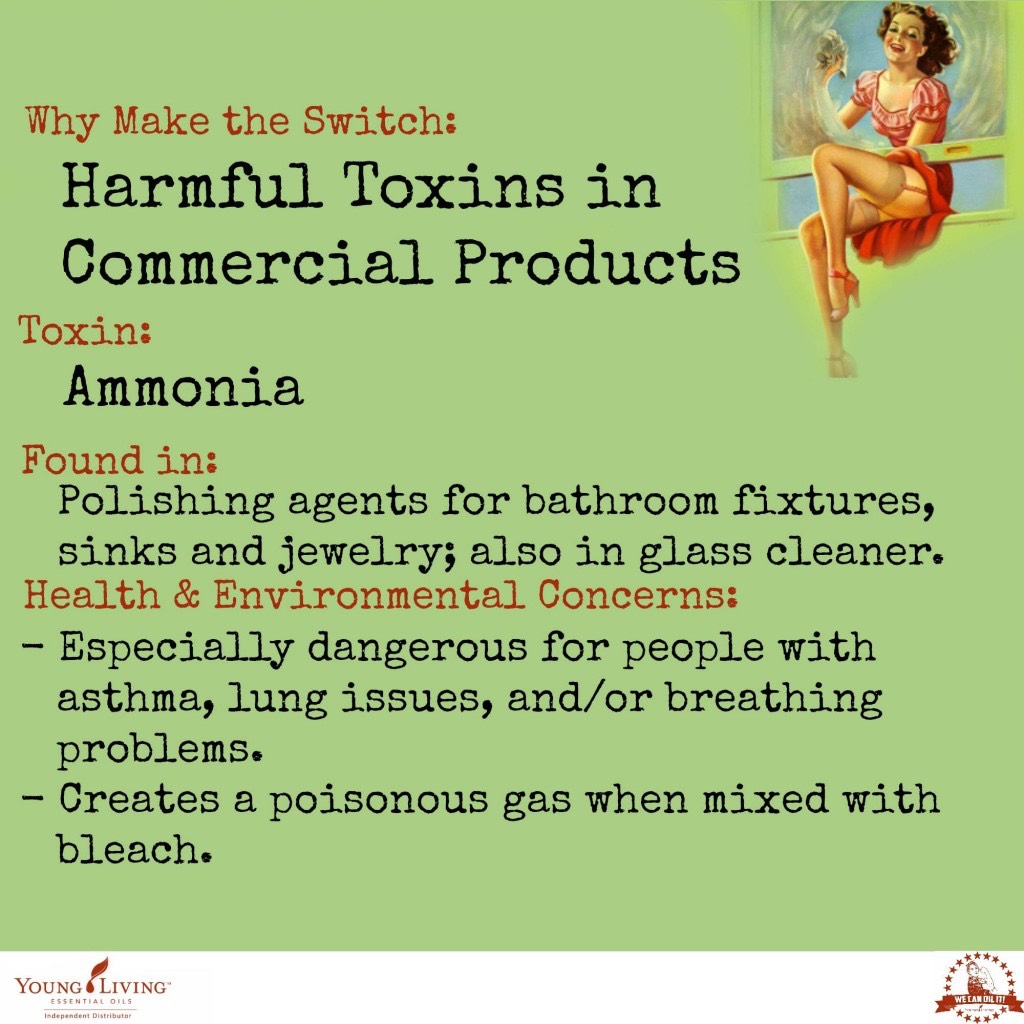
Unlike many of the toxins we've discussed, ammonia isn't known to carry long-term risk. It is a naturally occuring substance and dissipates in the environment fairly quickly. However, it does carry risk upon immediate exposure to high amounts of ammonia. For that reason, I wouldn't recommend that a family with small children keep it in their home.
Indoors, you may be exposed to ammonia while using household products that contain ammonia. Some of these products are ammonia-cleaning solutions, window cleaners, floor waxes, and smelling salts.Household and industrial cleaning solutions may contain ammonia, and use of these products at home or work may lead to exposure to ammonia. Both types of ammonia cleaning solutions are made by adding ammonia gas to water to form liquid ammonia. Household ammonia cleaners typically contain lower levels of ammonia (between 5 and 10%) compared to industrial cleaning solutions, which can contain higher levels of ammonia (up to 25%).
Farmers can be exposed to ammonia when they work with or apply fertilizers containing ammonia to fields. Farmers, cattle ranchers, and people who raise other types of livestock and/or poultry can be exposed to ammonia from decaying manure. Some manufacturing processes also use ammonia. Some older refrigeration units used ammonia as the refrigerant.Because ammonia evaporates and doesn’t leave streaks, it’s another common ingredient in commercial window cleaners. That sparkle has a price. “Ammonia is a powerful irritant,” says Donna Kasuska, chemical engineer and president of ChemConscious, Inc., a risk-management consulting company. “It’s going to affect you right away. The people who will be really affected are those who have asthma, and elderly people with lung issues and breathing problems. It’s almost always inhaled. People who get a lot of ammonia exposure, like housekeepers, will often develop chronic bronchitis and asthma.”
Also, ammonia can also create a poisonous gas if it’s mixed with bleach.Ammonia interacts immediately upon contact with available moisture in the skin, eyes, oral cavity, respiratory tract, and particularly mucous surfaces to form the very caustic ammonium hydroxide. Ammonium hydroxide causes the necrosis of tissues through disruption of cell membrane lipids (saponification) leading to cellular destruction. As cell proteins break down, water is extracted, resulting in an inflammatory response that causes further damage.
The Immediate Effects of Ammonia:Inhalation: Ammonia is irritating and corrosive. Exposure to high concentrations of ammonia in air causes immediate burning of the nose, throat and respiratory tract. This can cause bronchiolar and alveolar edema, and airway destruction resulting in respiratory distress or failure. Inhalation of lower concentrations can cause coughing, and nose and throat irritation. Ammonia's odor provides adequate early warning of its presence, but ammonia also causes olfactory fatigue or adaptation, reducing awareness of one's prolonged exposure at low concentrations.
Children exposed to the same concentrations of ammonia vapor as adults may receive a larger dose because they have greater lung surface area-to-body weight ratios and increased minute volumes-to-weight ratios. In addition, they may be exposed to higher concentrations than adults in the same location because of their shorter height and the higher concentrations of ammonia vapor initially found near the ground.
Skin or eye contact: Exposure to low concentrations of ammonia in air or solution may produce rapid skin or eye irritation. Higher concentrations of ammonia may cause severe injury and burns. Contact with concentrated ammonia solutions such as industrial cleaners may cause corrosive injury including skin burns, permanent eye damage or blindness. The full extent of eye injury may not be apparent for up to a week after the exposure. Contact with liquefied ammonia can also cause frostbite injury.
Ingestion: Exposure to high concentrations of ammonia from swallowing ammonia solution results in corrosive damage to the mouth, throat and stomach. Ingestion of ammonia does not normally result in systemic poisoning.
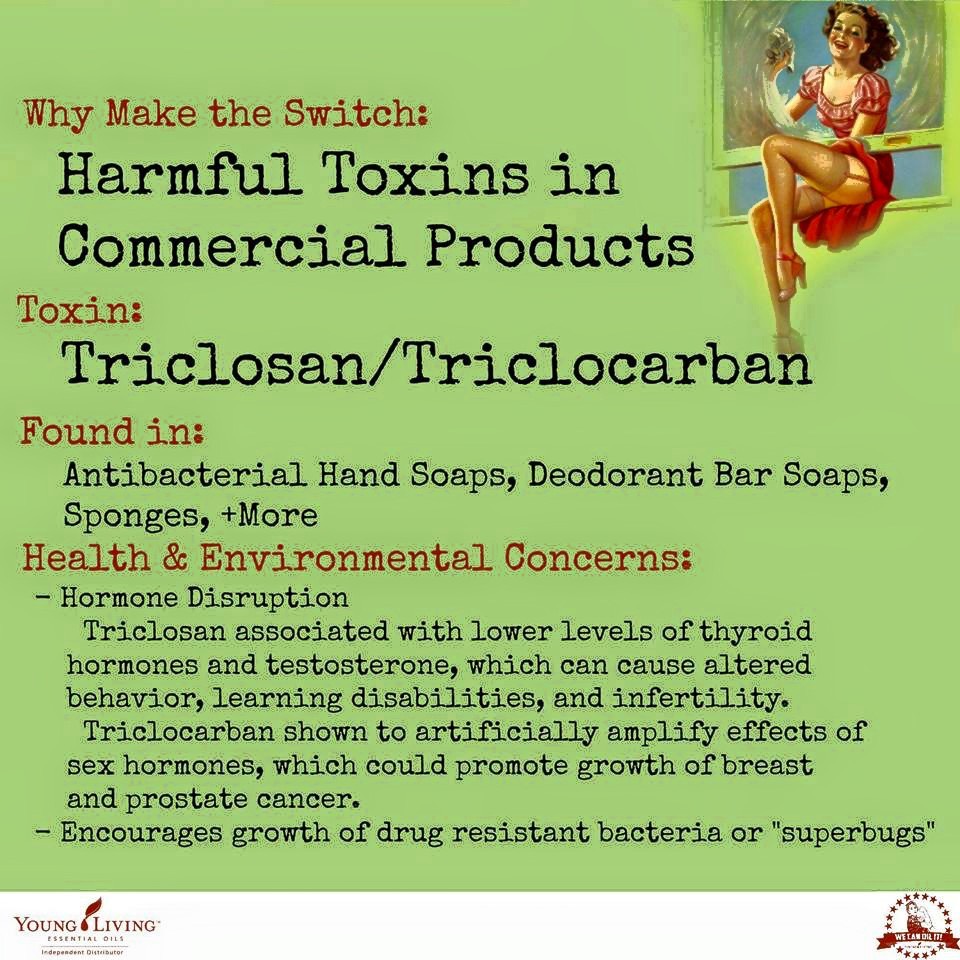
ENDOCRINE DISRUPTOR!!
Triclosan is one of the most prevalent antibacterial compounds found in products. Over the last few years, as a direct result of pressure from consumer groups and the media regarding the need for triclosan in consumer products and the mounting scientific evidence documenting adverse health effects, including impacts to the thyroid hormone, some major manufacturers have quietly reformulated their products without triclosan.
Studies have increasingly linked triclosan (and its chemical cousin triclocarban), to a range of adverse health and environmental effects from skin irritation, endocrine disruption, bacterial and compounded antibiotic resistance, to the contamination of water and its negative impact on fragile aquatic ecosystems. Recent evidence suggests that triclosan may play a role in cancer development, perhaps through its estrogenicity or ability to inhibit fatty acid synthesis. It can be detected in breastmilk, urine, and semen.
When introduced to the market in 1972, triclosan was confined to hospital and health care settings. Since then triclosan exploded onto the market place in hundreds of consumer products ranging from antibacterial soaps, deodorants, toothpastes, cosmetics, fabrics, toys, and other household and personal care products. Triclosan’s success on the consumer market has been aided by the false public perception that antibacterial products are best to protect and safeguard against potential harmful bacteria. However, an article in the journal Clinical Infectious Diseases, entitled "Consumer Antibacterial Soaps: Effective or Just Risky?" (2007), concludes that antibacterial soaps show no health benefits over plain soaps. In 2010, FDA stated that, “Existing data raise valid concerns about the [health] effects of repetitive daily human exposure to [triclosan]” and announced plans to address the use of triclosan in cosmetics or other products. They have "accelerated" discussions to five years sooner than originally planned, and hope to have a ruling September of 2016. Read that sentence again. 2016!
Scientific evidence, though, has prompted legislation in Minnesota to ban the sale of products containing the toxin effective September 2017. Likewise, companies like Proctor & Gamble and Johnson & Johnson have recently started reformulated products without Triclosan.
With this nasty toxin causing health and environmental issues for over 40 years, we can only hope that companies and our government come to their senses soon. Until then, it is wise to avoid use of products containing Triclosan and Triclocarban.
See a list of common products containing Triclosan: http://www.beyondpesticides.org/antibacterial/products.php

Quats:
How many of you are still using dryer sheets?
Found in: Fabric softener liquids and sheets, most household cleaners labeled “antibacterial.”
Health Risks: Quats are another type of antimicrobial, and thus pose the same problem as triclosan by helping breed antibiotic-resistant bacteria. They’re also a skin irritant; one 10-year study of contact dermatitis found quats to be one of the leading causes. According to Sutton, they’re also suspected as a culprit for respiratory disorders: “There’s evidence that even healthy people who are [exposed to quats] on a regular basis develop asthma as a result.”
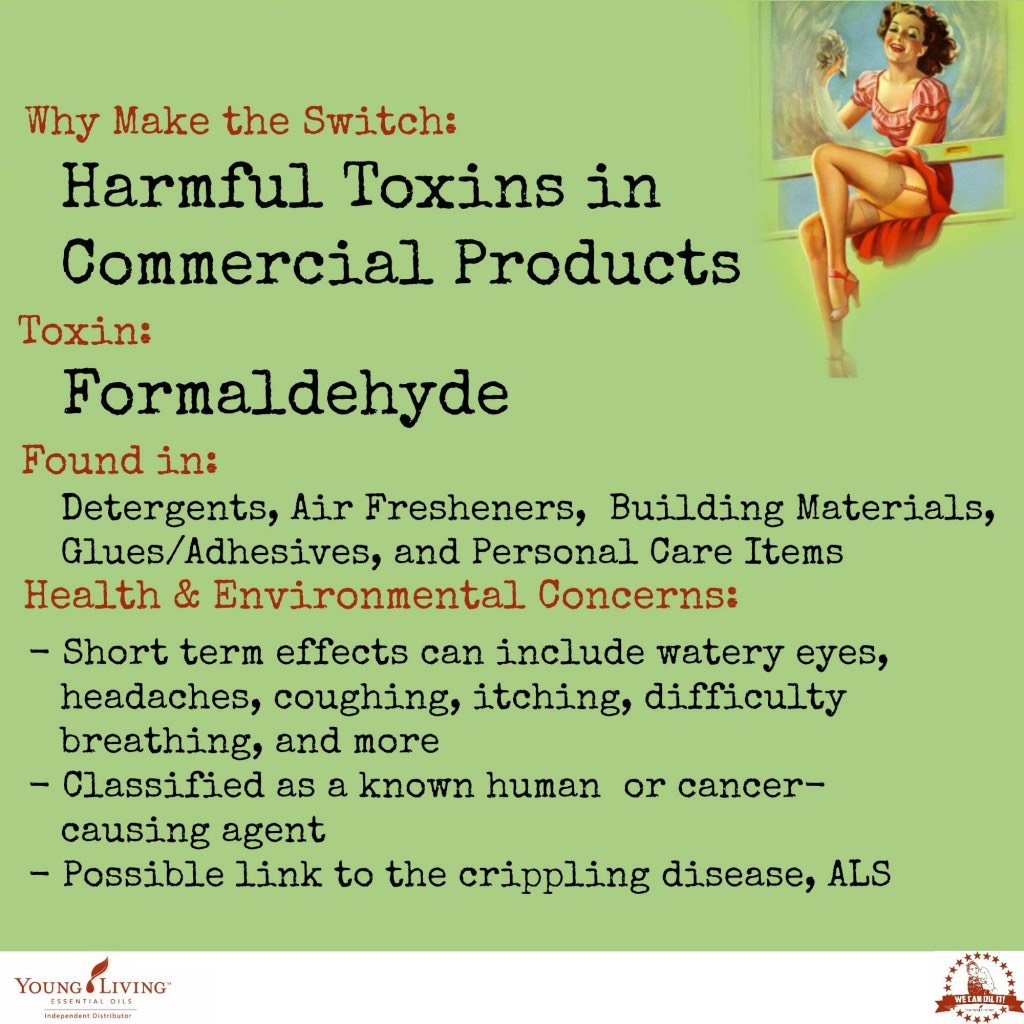
Formaldehyde:Most of us are familiar with formaldehyde from the glory days of dissecting frogs or cats in high school biology. That pungent smell will forever be ingrained into our heads!
Well, did you know that formaldehyde is also a very common toxin that pollutes the air in almost every American home?
Formaldehyde is a colorless, flammable, strong-smelling chemical. In addition to being found in some detergents, it is used in pressed-wood products, such as particleboard, plywood, and fiberboard; glues and adhesives; permanent-press fabrics; paper product coatings; and certain insulation materials. In addition, formaldehyde is commonly used as an industrial fungicide, germicide, and disinfectant, and as a preservative in mortuaries and medical laboratories. Formaldehyde also occurs naturally in the environment. It is produced in small amounts by most living organisms as part of normal metabolic processes.
Formaldehyde is linked to various forms of cancer in both animal and epidemiology studies. It is classified by the EPA, International Agency for Research on Cancer (IARC), and the National Toxicology Program, an interagency program of the Department of Health and Human Services, as a human carcinogen.
Also, recent news links formaldehyde with ALS, a progressive neurodegenerative disease that affects nerve cells in the brain and the spinal cord. You may remember ALS from the Ice Bucket Challenge. Read more about this new link here: http://www.nbcnews.com/…/study-strengthens-formaldehyde-lin…
For a list of products with formaldehyde in it: http://hpd.nlm.nih.gov/cgi-bin/household/search…
A note about air fresheners: Though not listed on the label, formaldehyde is a major concern when it comes to synthetic air fresheners. Why? Compounds inside react with oxygen to form formaldehyde.
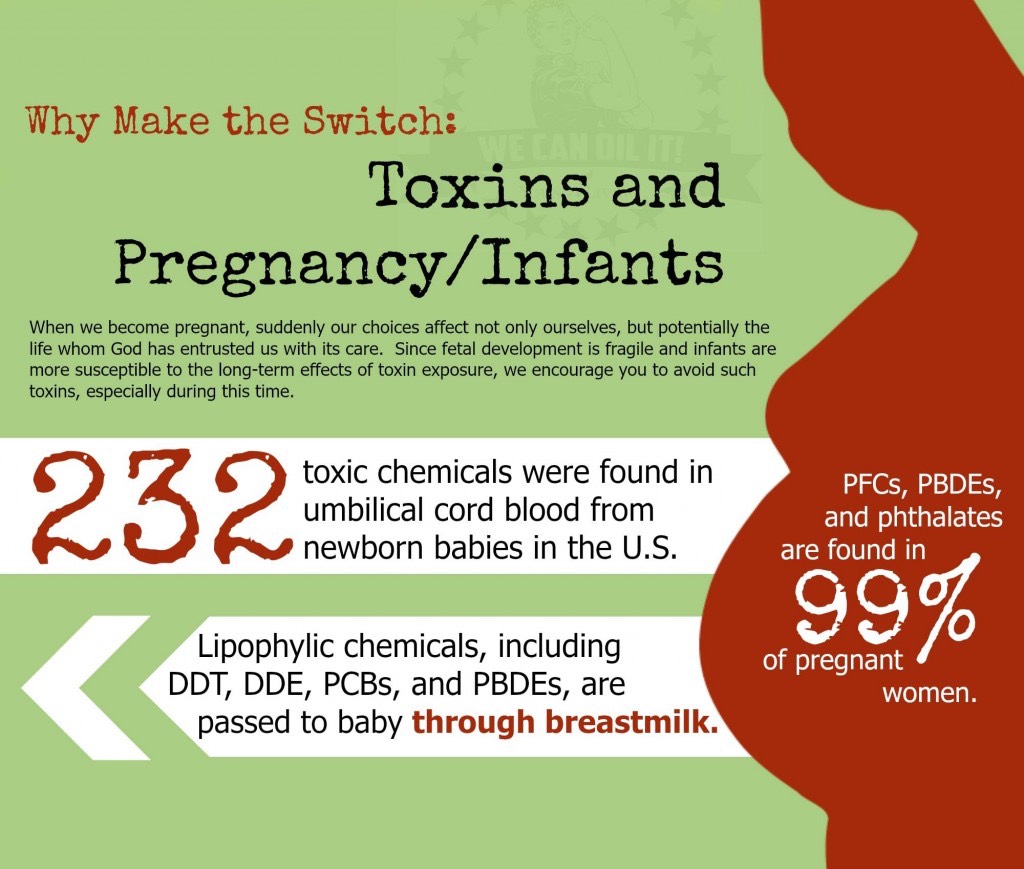
So much I could say here, but I think the slide says it all. This concerns me as a woman, as a mother, as a grandmother, as a midwife. You, as most likely the major decision maker about the products brought into your home, are all that stands between a chemical laden family and a healthier lifestyle for you and your family. Choose well!
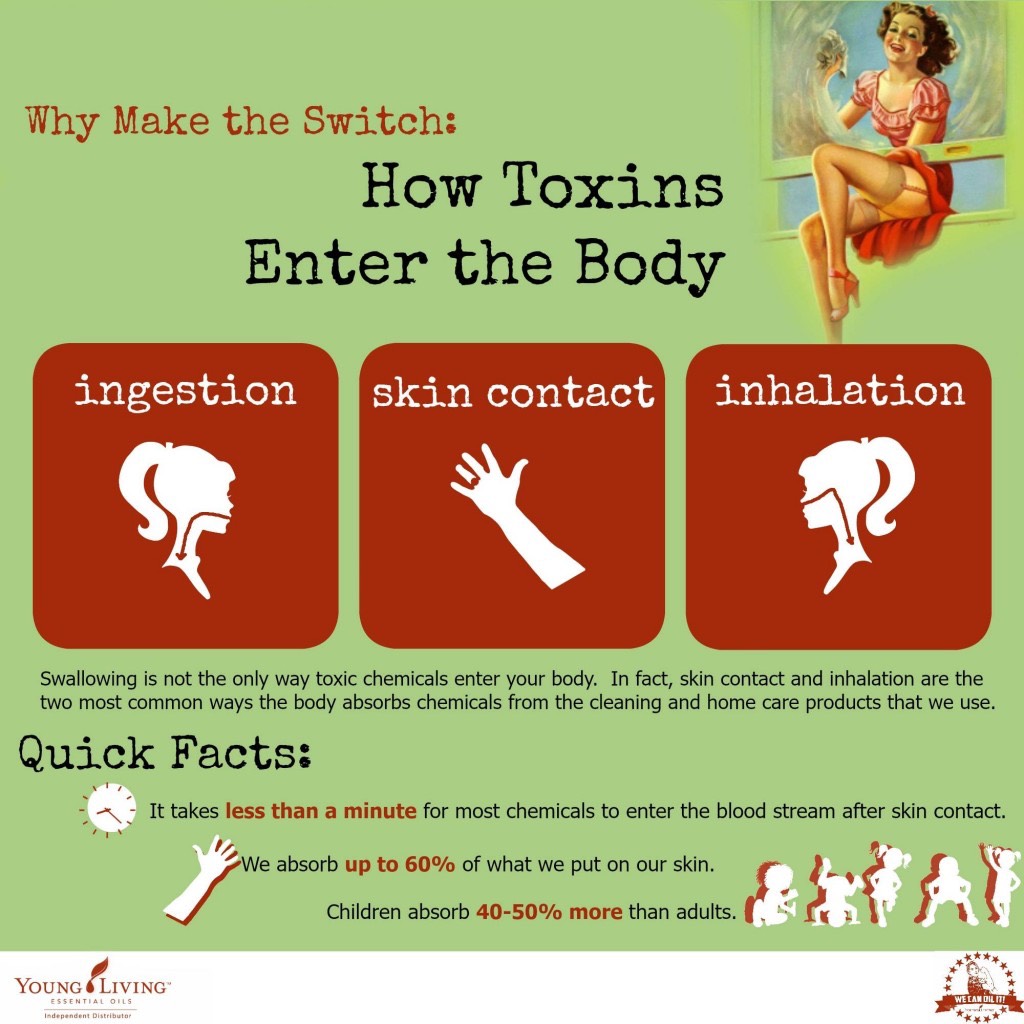
Just because you don't swallow it doesn't mean it doesn't get in...Toxic chemicals make their way into our bodies in three key ways:- the lungs (inhalation),- skin (dermal absorption), and/or- mouth (ingestion).
Breathing of contaminated air is the most common way that cleaning chemicals enter the body. Some chemicals, around 60% of them, when contacted, can pass through the skin into the blood stream. Less commonly, cleaning chemicals may be swallowed accidentally if food or cigarettes (or hands) are contaminated.
While other methods of entry, like injection, the eyes, and other orifices, are possible, they are not very likely.
Regardless of the way the chemical gets into the body, once it is in the body it is distributed to anywhere in the body by the blood stream. In this way, the chemicals can attack and harm organs which are far away from the original point of entry as well as where they entered the body. They can be stored in tissues, like fat or bone, or excreted.
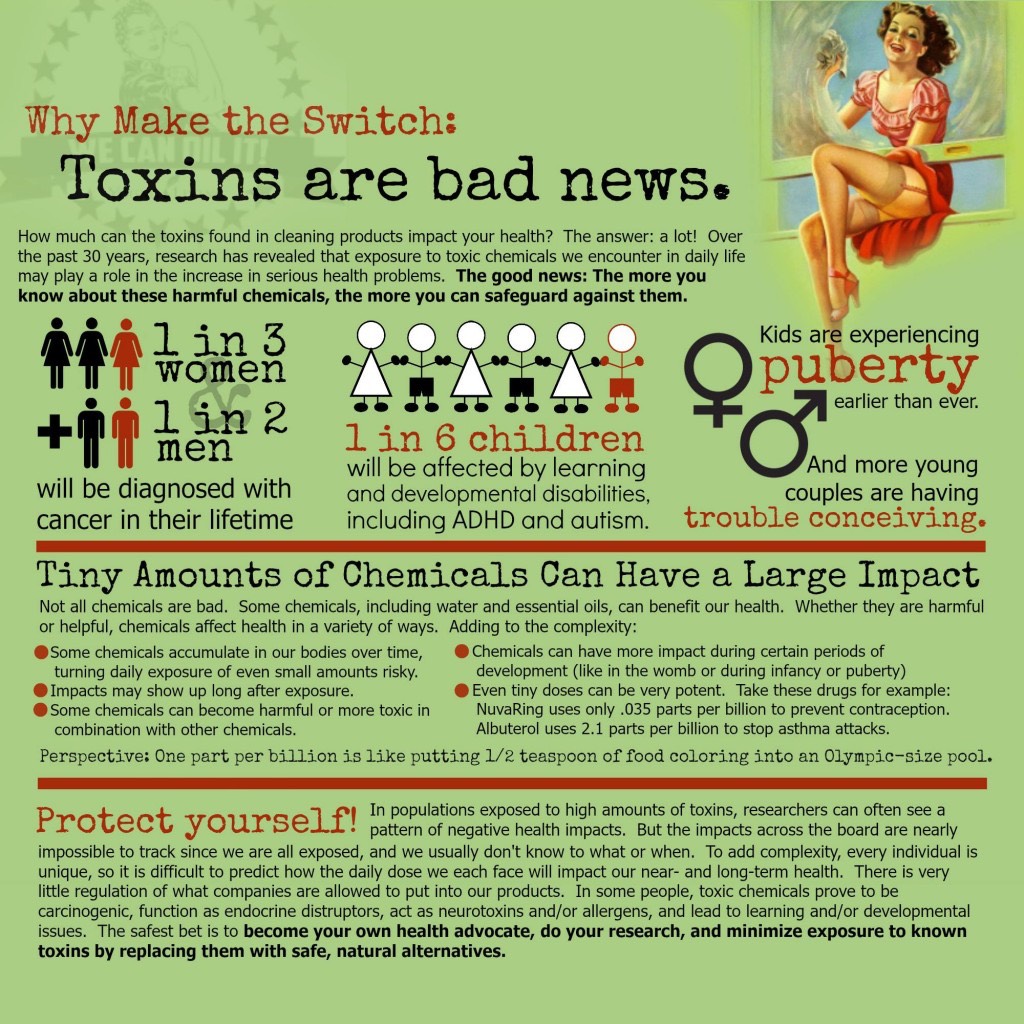
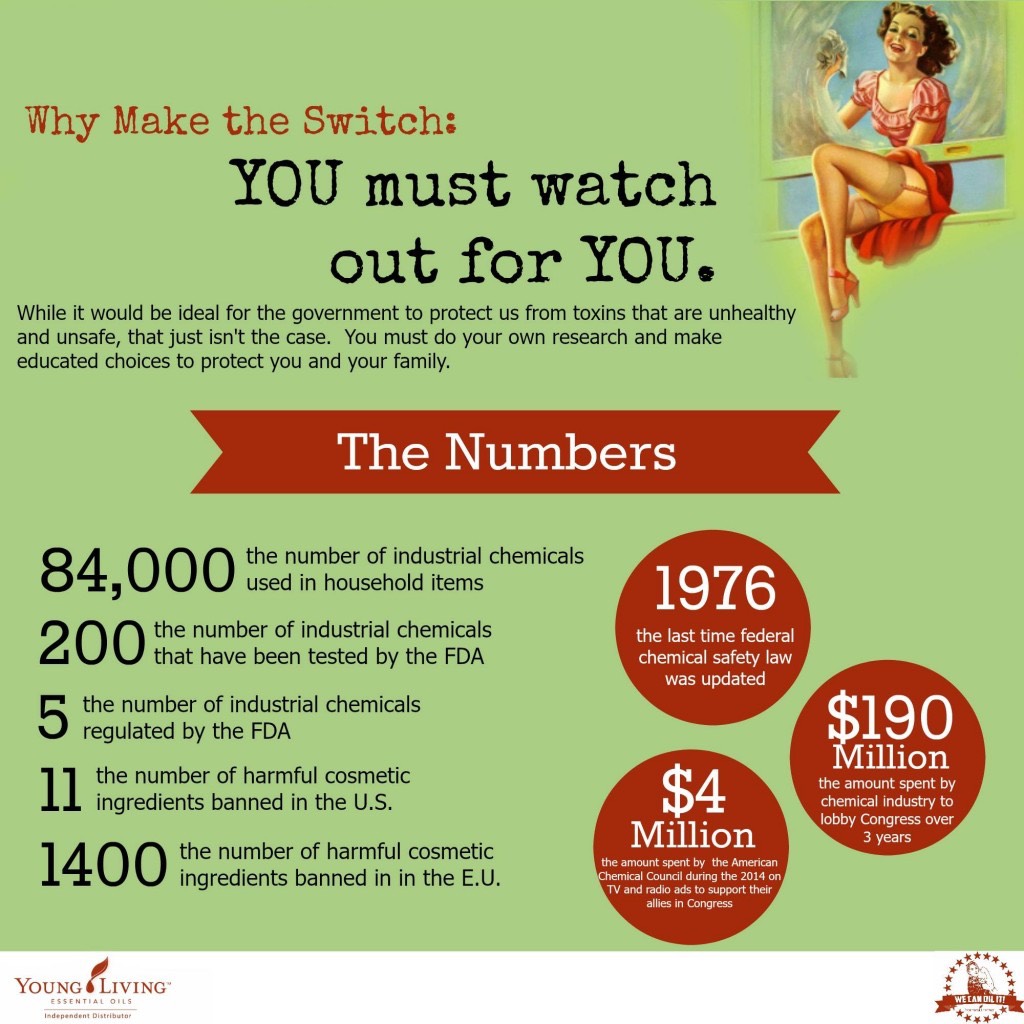
Why Switch?
How many people, like me, suffer from allergies? Sure, there are the commonly known culprits such as pet dander, mold, ragweed, and pollen. But did you know that your cleaning products could also be making you sick?
Some cleaning products contain chemicals that can trigger an allergy by themselves, while others have ingredients that can combine with proteins to form “haptens” that trigger reactions. Some products also release dangerous chemicals, including volatile organic compounds (VOCs), which may remain in the air for up to 20 minutes after use. These VOCs and other chemicals contribute to chronic respiratory problems, allergic reactions, and headaches.
Another major factor in your allergy fight: fragrances. Fragrances are collectively considered among the top five allergens in the world. They are found in everything from personal care products (body wash, shampoo, etc) to household cleaning products (especially air fresheners). The thing about fragrances, though, is that because they are proprietary formulas, companies are not required to disclose their components on ingredient labels. Great for the company and its intellectual property...not so great if you happen to be allergic to one of those components. Every time you spray that aerosol room spray or plug in that aromatically pleasing candle warmer, you are releasing a number of unknown and potentially harmful substances into the air.
Don’t think fragrance is a big deal? Consider this:- Researchers at the Universities of Washington and West Georgia who surveyed everyday Americans’ experiences with fragranced cleaning supplies found that nearly one in five suffered headaches, breathing difficulties or other problems when exposed to air fresheners.
- A study led by Alexandra Farrow of Brunel University in the United Kingdom linked air fresheners in the home to higher incidence of diarrhea and earaches in infants and headaches and depression in their mothers.
- A Swiss study published this year found that use of air freshening sprays 4-7 days a week was associated with reduced heart rate variability, a marker of autonomic cardiac dysfunction.
Scary stuff, huh? But don’t worry! There are safe alternatives, which we’ll get into later in this class!
Even if your cleaning products don’t trigger your allergies, they can still be irritants. It should come as no surprise that many cleaning supplies or household products can irritate the eyes, throat, or skin or cause headaches or other health problems. Many harsh chemical cleaners can cause direct, painful irritation of the skin, eyes, nose, throat and lungs. The very properties that make cleaning products effective can also mean that they inflame delicate tissues. There’s a reason many traditional household cleaners include poison control warnings; instruct users to wear gloves, masks, and eye protection; and warn against contact with skin. I don’t know about you, but I don’t want to have to don a hazmat suit to make sure my house is clean. (And what about the surface afterwards? You’re supposed to feel confident that you- and your kids- can eat off it? Touch it? No thanks!). I won’t get into it now, but fortunately, Young Living has some great natural, plant-based cleaning solutions that ACTUALLY WORK and you can feel comfortable using in your home!
(source: Environmental Working Group)
On topic concerning chemical free lifestyle, but not necessarily about cleaning products, we should all equally care about the chemicals that are used in the growing and treatment of our FOODS! Read this article about what happened with one family when they tried an experiment by only eating ORGANIC foods for a period of time. Their laboratory results were pretty conclusive that these chemicals are in our bodies, BUT it doesn't take that long to be committed to eating organic before it makes a BIG DIFFERENCE!

So, we've quite possibly scared your pants off about all of these nasty toxins that are in our cleaning products. But where do you go from here?
The answer: Natural.
By switching to natural-based products, you can get throw out (responsibly) those toxins for safe alternatives.
Here's the kicker... with tips and tricks, you will NEVER miss those chemical-laden commercial products. Whether you have time to spend all day making products or just want something that works well without the hassle, our team of ladies will share great info on how to clean naturally and clean well. You will be sure to wonder why you hadn't switched sooner.
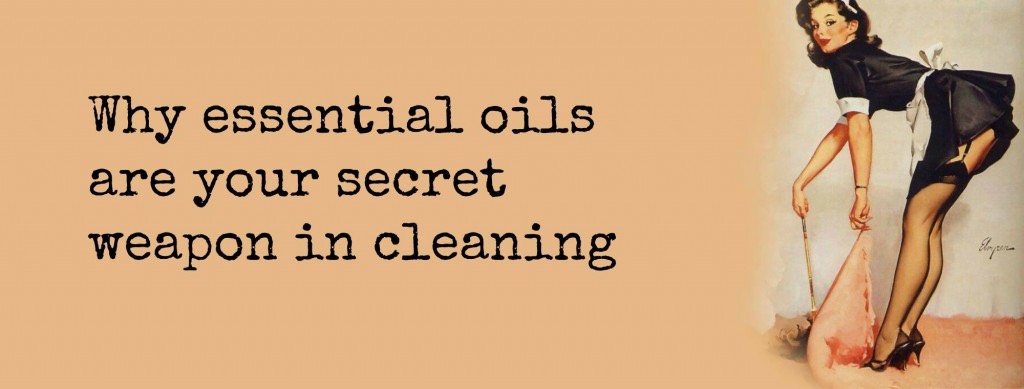
Let's talk a bit about essential oils.
Essential oils are the essence of the plant. Each plant carries its own unique essential oil, and for the plant, this oil acts as its defense mechanisms, giving it the ability to ward off disease and predators, adapt to stressors, and more. Depending on the chemical constituents found in an oil, it carries various properties particularly beneficial to that plant. Similarly, these properties carry over to be very beneficial to our bodies as well, supporting immune health, elevating the mood, and balancing our body systems. It is my opinion that our bodies are divinely designed to benefit from these plants and herbs, as I find it not mistake that Adam and Eve started in a garden.
When distilled out into its purest form, essential oils are very powerful. To give a small glimpse of that, consider:- It takes the rind of 43 lemons to make a 15mL bottle of Lemon essential oil.- One cup of peppermint tea carries the same therapeutic benefit as a single drop of peppermint essential oil.- It takes over 10,000 roses to make a 5mL bottle of pure Rose essential oil.
Well, just as they are great for our bodies and our overall health, they pack a powerful punch when used in our cleaning regimens. Just a small amount can exponentially increase the cleaning power of other natural cleaning agents. Only, instead of wreaking havoc on our body and suppressing our immune systems like their toxic counterparts, we can actually potentially gain positive side effects from the use of these oils while cleaning. Pretty cool, huh?
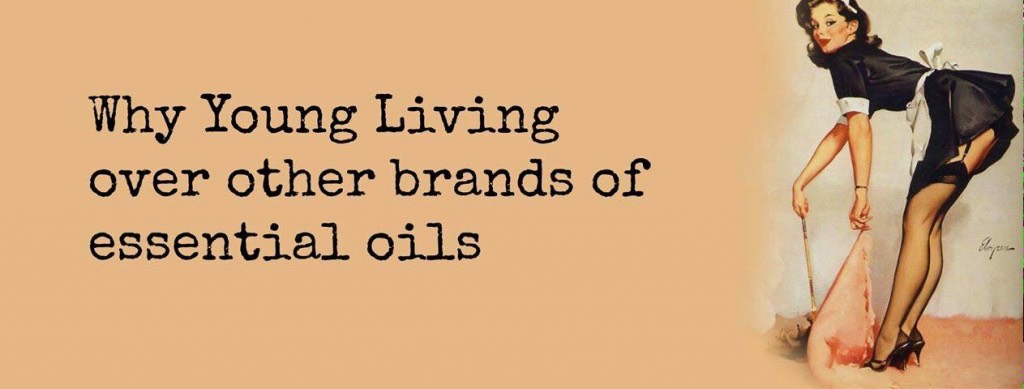
Everyone ready for some SOLUTIONS?
All essential oils are not the same. There are many, many factors that go into a pure essential oil.
Why does this matter? Simply enough, impure essential oils can be less effective and depending on what the impurities are, can actually be harmful and toxic.
Think of it this way...
If it takes 10,000 roses to make a 5mL bottle of pure, therapeutic-grade Rose essential oil, does it make sense that you could buy a bottle from your neighborhood health food store for $10? That rose oil is not pure. (Note: Just because it says "pure" doesn't mean a thing. The wording on cosmetics is not regulated or policed, so companies can claim purity all they want with absolutely false claim). It is either diluted, possibly with water, making it less strong. Or... to maintain a strong scent that customers will enjoy, companies often cut oils with synthetic fragrance and toxic chemicals. Don't forget why you were making the switch to begin with...
Also consider this... France exports twice as much lavender oil as it is even capable of producing. Let that sink in. So, companies in the US may very well think they are buying pure oils, yet are being sold synthetic replacements. They then in turn sell that synthetic impostor to you.
I'm not here to trash talk other oil companies, though. I couldn't tell you what other oil companies are better or not. I can just say this... Young Living does everything in its power to put the purest and most potent essential oils on the market.
It is like this: Counterfeit currency experts don't study counterfeit bills to become proficient in spotting them. They study the real ones to be able to detect a fake. Young Living is the real deal. With over 20 years producing and studying essential oils, they are unparalleled in the market.
Why do I say this? Young Living calls it their Seed to Seal Guarantee, made possible by the fact that they own their own farms. What that means to us...
1. Young Living has studied which species of plants produce the most beneficial essential oils. They start with seeds of those species to ensure that, from the very start, they are on their way to growing healthy plants specifically for potent oil production.
2. Young Living goes above and beyond organic farming practices. For example, when you visit their farms, which you absolutely can with as short as a 30 minute notice, it isn't uncommon to see crews handpicking weeds from the fields. They use reject batches of essential oils as herbicides and insecticides. They house their own worm farms to produce natural plant foods, fueled by a mixture of enzymes and plant matter left over from the distillation process.
3. Young Living houses their own distilleries. They have done a whole lot of R&R to find the perfect temperature and the perfect distillation time to yield the perfect oil for each and every plant. They ensure that oils never touch impure metals or plastics during the distillation process and have patented, stainless steel distilling machinery to ensure this.
4. Young Living tests every batch of oil, both in in-house labs as well as by third party testing companies. If constituent counts don't measure up to as good as they should be, those oils are not bottled. Instead, they are used on the farms where needed (see #2).
5. Young Living also controls the transportation and bottling of all of its oils, ensuring again that they aren't compromised. Young Living uses stainless steel drums. Look up the cost of one of those babies, and you will see just how far Young Living goes to keep your oils pure. They are bottled and sealed, still maintaining its purity.
Wow, huh?
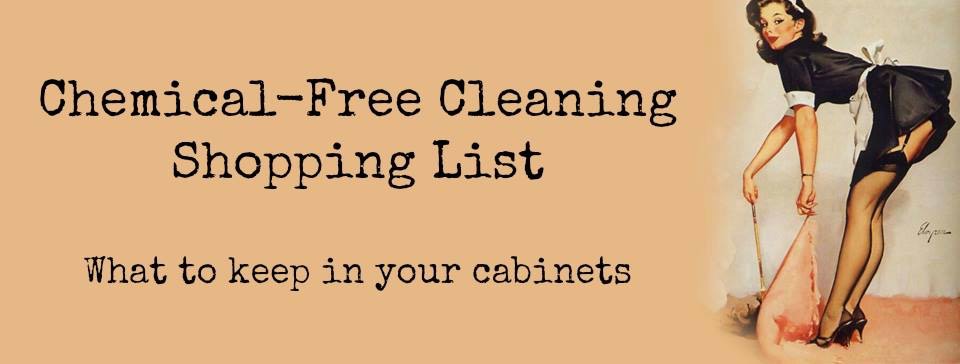
When you are preparing to make the switch to a chemical-free lifestyle, there are a few items that we would recommend that you purchase to get yourself started. You will see these ingredients and materials pop up in the posts to come throughout the rest of the series. If you have anything else that you would recommend, let us know in the comments!
-Thieves Household Cleaner-baking soda-vinegar
-Castile soap (we recommend liquid)
-hydrogen peroxide
-lemon juice
-super soda
In addition, these are our favorite Young Living essential oils to help make and maintain a chemical-free home:
-Thieves-Purification-Lemon-Tea Tree-Lavender-Pine
What sorts of containers will you need? This exact list will depend on what you are making, but here are some ideas. You can find these at your local dollar store, Amazon.com, BulkApothecary.com, AbundantHealth4U.com.
-spray bottles-open mouth containers/sugar containers-baby wipe containers-jars
Oh, and you can save a few dollars by learning to convert your empty kitchen bottles into new containers for your cleaners!
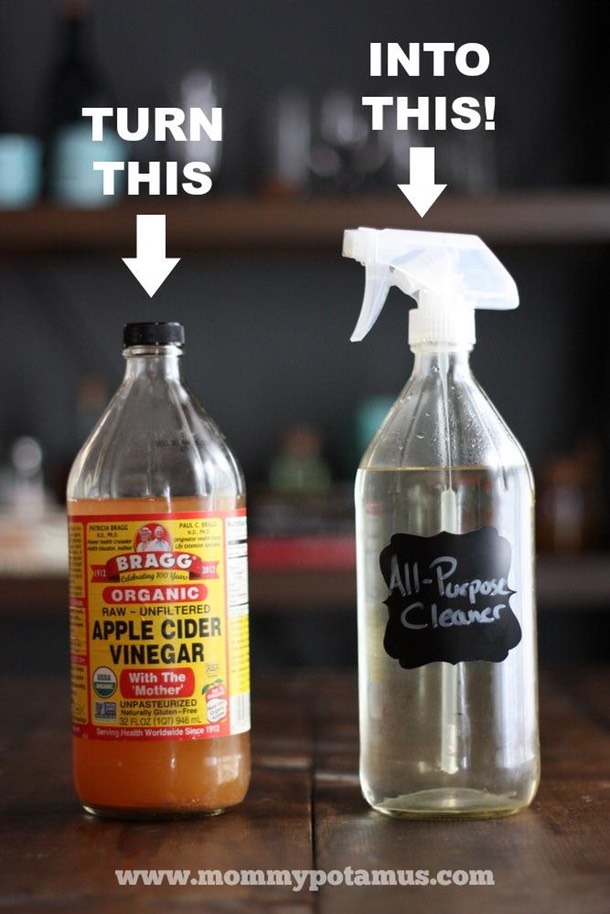
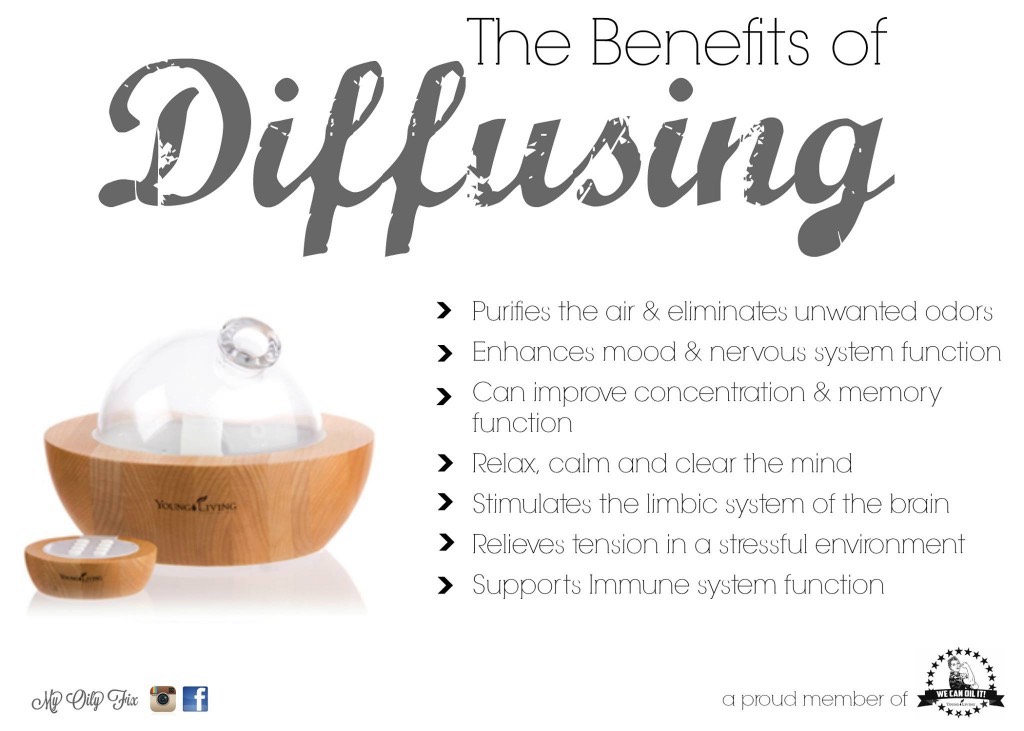
Instead of scented candles and room fresheners, etc which have harmful chemicals, WHY NOT use something that will not only accomplish freshening your room but give you ADDED health benefits?
Before my essential oil journey began I mistakenly thought essential oils were just fragrances that smelled good. Once I did more research on the benefits of inhaling unadulterated, pure, therapeutic grade essential oils I was floored! Not only can diffusing benefit me but it can benefit my whole household. Another cost effective way to use Young Living Essential Oils! Diffusers disperse essential oils as a fine vapor throughout the air so they can be absorbed gently into the body through the respiratory system. The aroma can prompt the nervous system to transmit signals to the limbic system in the brain – the same part of the brain that houses emotion and memory. Hence, in less than a second the brain can respond by stimulating various psychological & physiological functions.
So, let's start sharing some cleaning "recipes" so you can start switching out your old chemical laden products for a healthier version that still gets your house sparkling, OK?
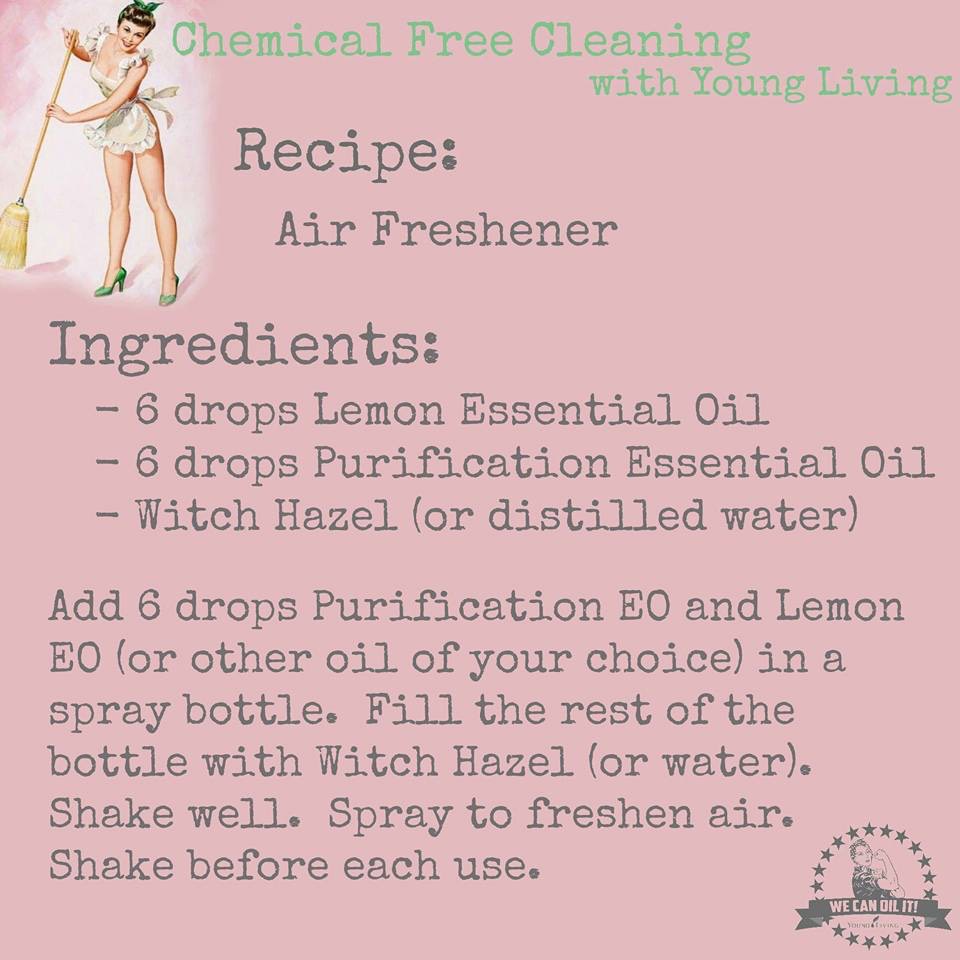
Normally, if I want to freshen the air in my home, I turn on my diffuser with a few drops of whatever I'm feeling at the moment (Purification, lavender, Citrus Fresh, etc). But sometimes you just need a quick, directed way to freshen the air (or toys, blankets, pillows, rugs...). Enter this super easy spray bottle air freshener!
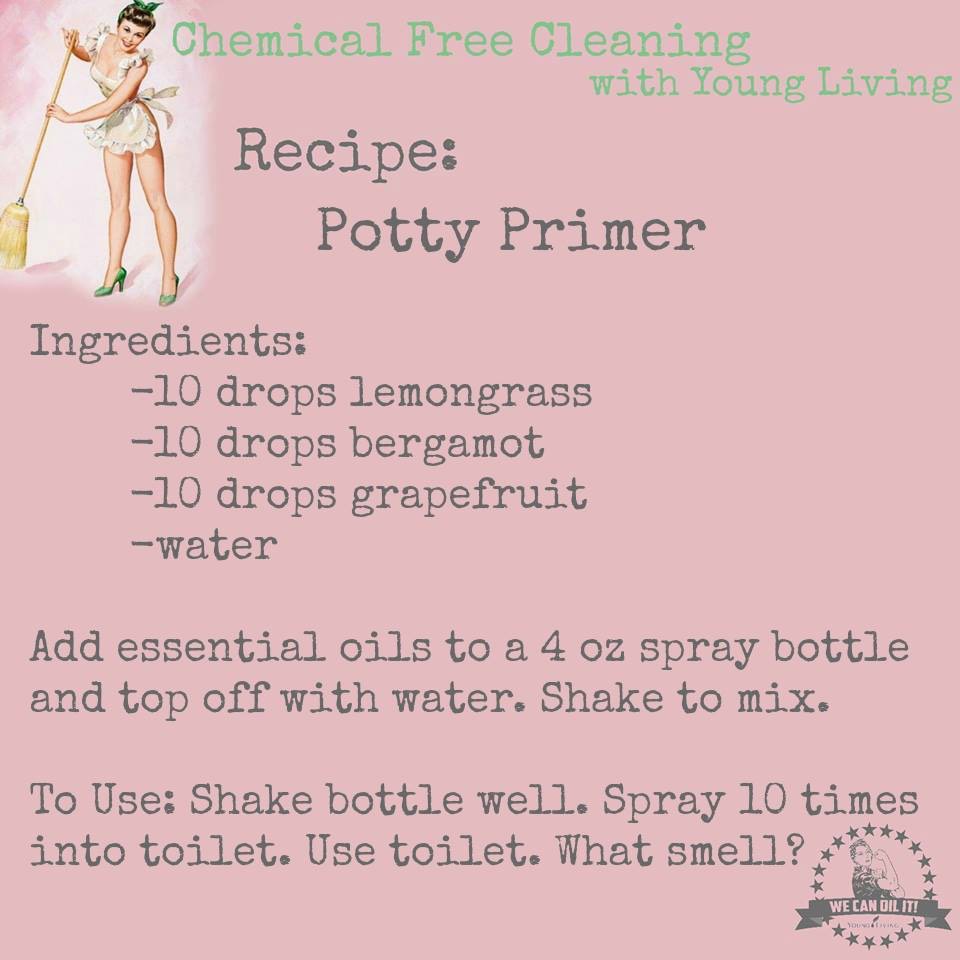
Now laugh if you want to, but this recipe for a Potty Primer WORKS. What is a Potty Primer? It is something that will hide those bathroom smells. Get rid of the matches or other bathroom fragrances, because this is seriously all you need! All you have to do is shake the spray bottle, spray it in the toilet 10 times before you go, and then go. No smell afterwards!
You can actually get mini spray bottles and keep it with you so that if you are at a friend's house, you can use this and not be embarrassed afterwards. They also make great gifts (your friends will not only laugh but love it).
BTW, I purchased some of the "name brand" of a similar product and simply can not use it, the scent is SO STRONG and artificial. Once you get used to the real deal with therapeutic grade essential oils, anything else is just annoying.
Commercial oven cleaners are no joke. That stuff is some nasty stuff! And, in my opinion, they don't work all that well.
Welp, I tried a natural method using baking soda... Never. Going. Back!
I've lazied up my ways, so I shared my lazy version using my all-purpose cleaner (or diluted Thieves Household Cleaner) with baking soda.
What natural methods do you use to clean your oven?
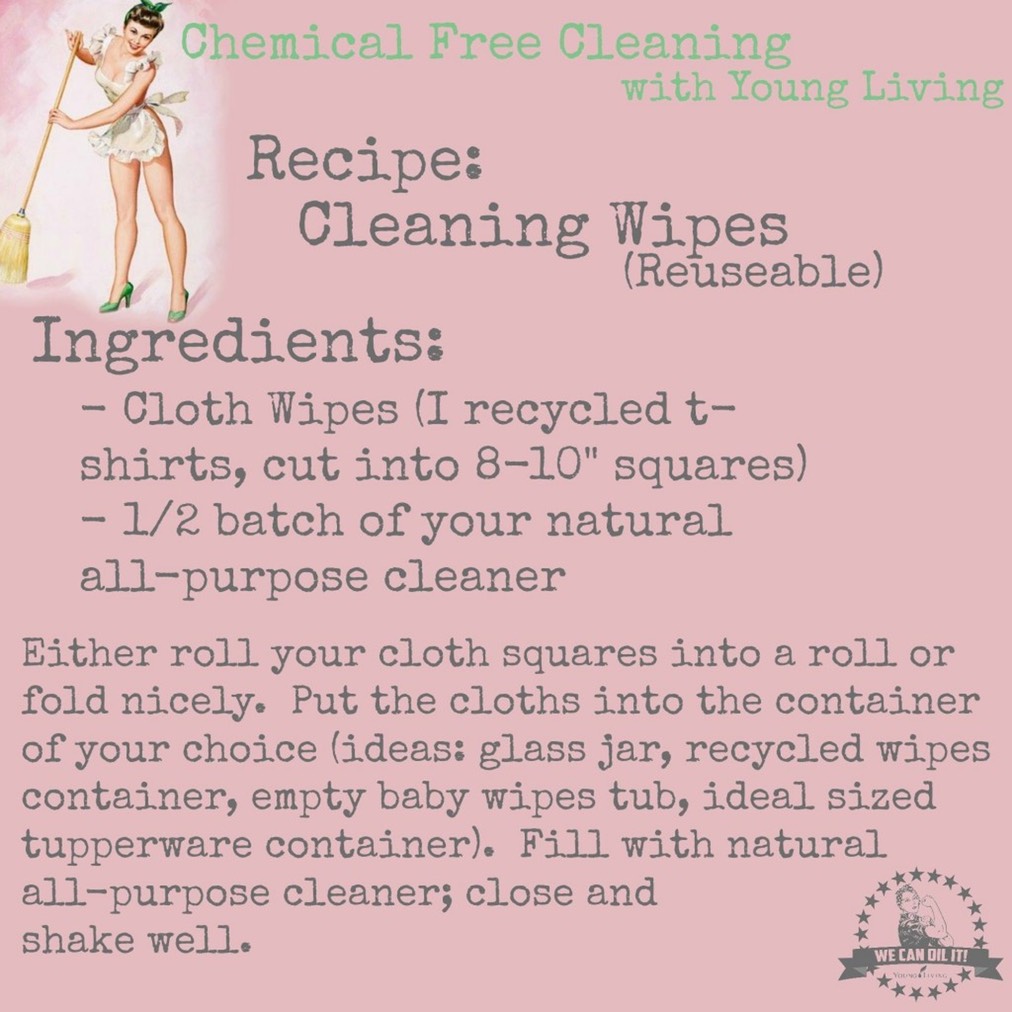
I know I was totally addicted to the convenience of cleaning wipes before going natural! How about you?
Well, check out how easy it is to make your own. I personally like the disposable method, which I recognize that I am not being as eco-conscious as I should. But you can so easily purchase some thin clothes wipes too and simply wash them again and again, saving a LOT more $$
So here's the deal... pick your wipes, whether disposable or washable, and then add in a half batch of your all-purpose cleaning recipe. You can use diluted Thieves Cleaner posted today. It's that easy.
If you prefer to use a sturdy paper towel, use one like Viva. It would also be wise to use a bleach free option, but I haven't found one I love as much as Viva. So, if you know of one, comment below!
These can be placed in diaper wipes container or a used cleaning wipe container.
Do you use homemade cleaning wipes? If so, what's your recipe?
This is a GREAT source for some reusable cloths for making your own wipes.

Did you know Febreze Fabric Refresher gets an "F" from the Environmental Working Group? Yikes, right?
Well, essential oils to the rescue. Next time you want to freshen fabric in your home, whip up this little spray and feel confident that you are exposing your family to less toxins by making the switch.
Some of the essential oils I like to use: Purification, Lavender, Peace & Calming, Joy, Thieves, Citrus Fresh, Lemon, Orange
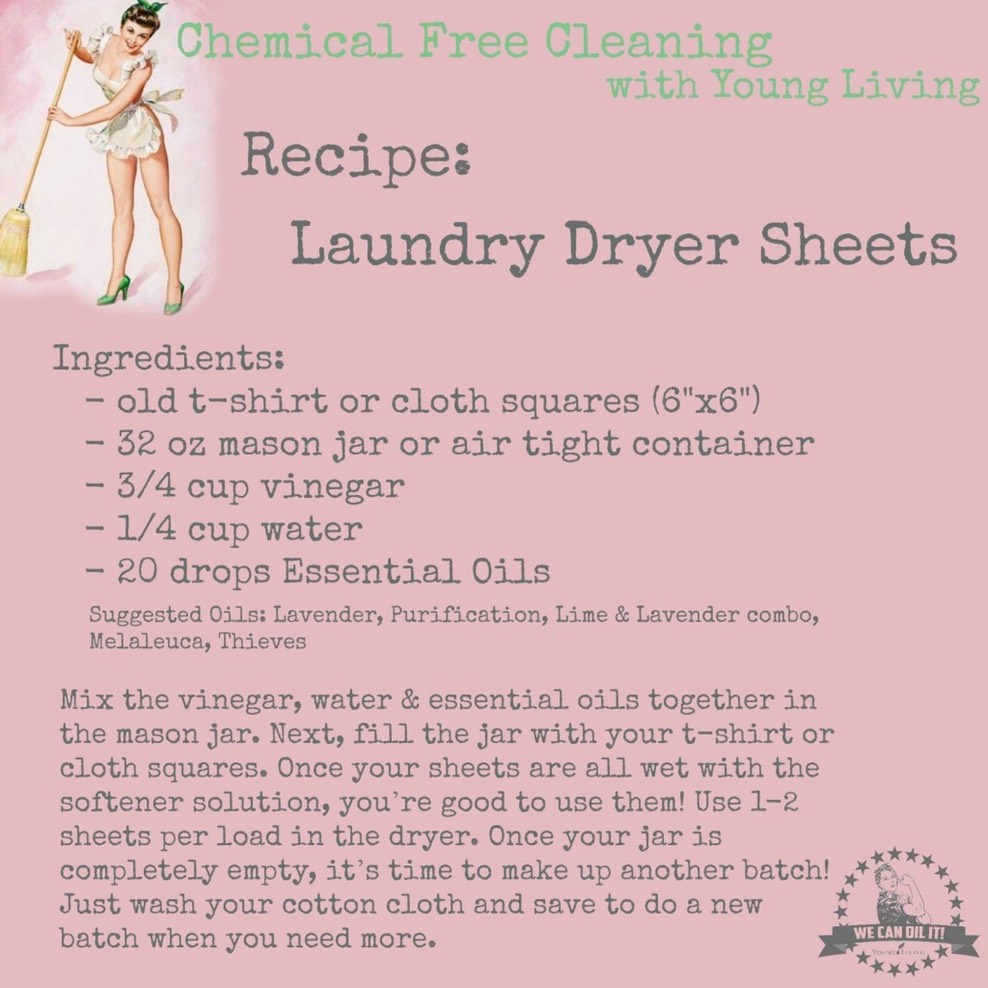
I have made these several times and just keep them in a jar on top of my dryer, using the same reusable cloths from the Etsy store mentioned above.

Fabric softener! Another one of those culprits that are laden with chemicals. If you really love having softer clothes, here is a GREAT alternative!
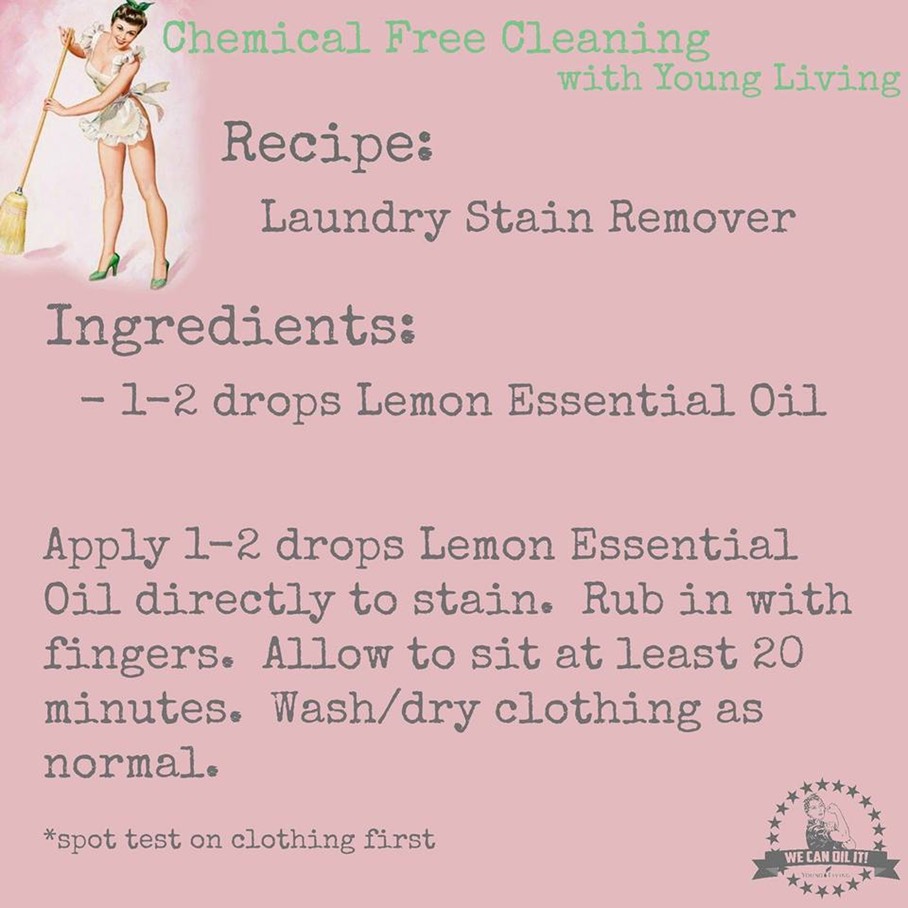
What can I say? Stains happen. Did you know that Lemon essential oil was SO versatile?
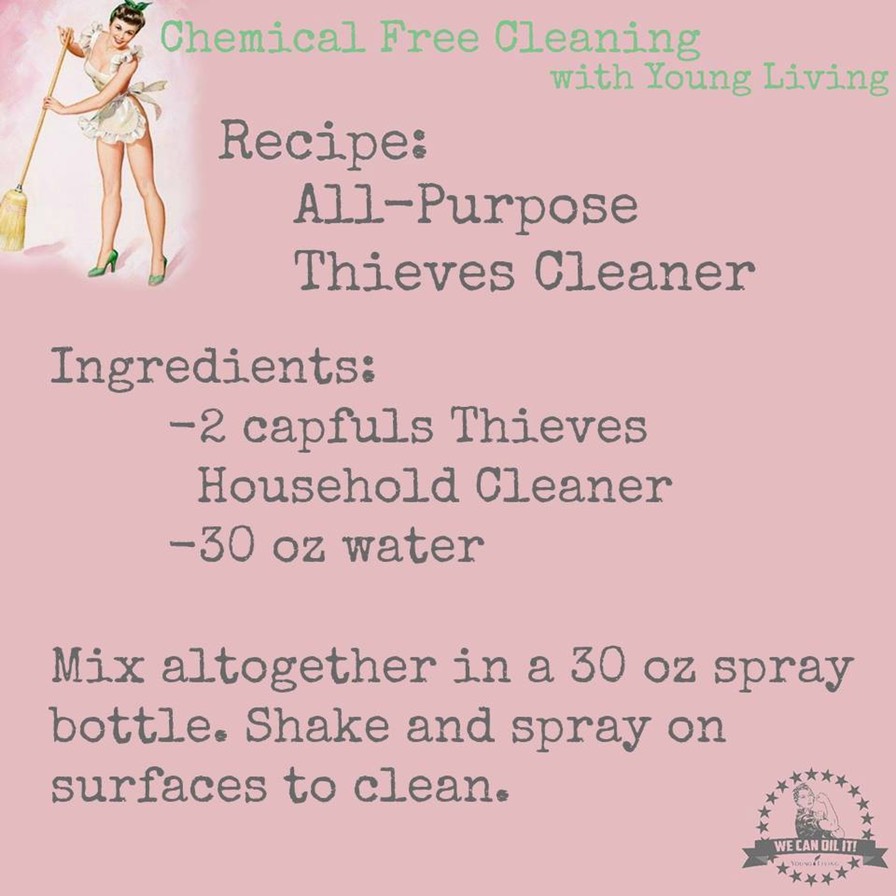
This is the ratio to use for general household cleaning in a spray bottle. I keep several of these all over the house. I LOVE it in the bathrooms and kitchen especially. You would NOT BELIEVE how it cuts through food and grease on my stove and it SHINES afterwards.

THIS placed in a glass shaker container is awesome to freshen up carpets from pets, children, LIFE!
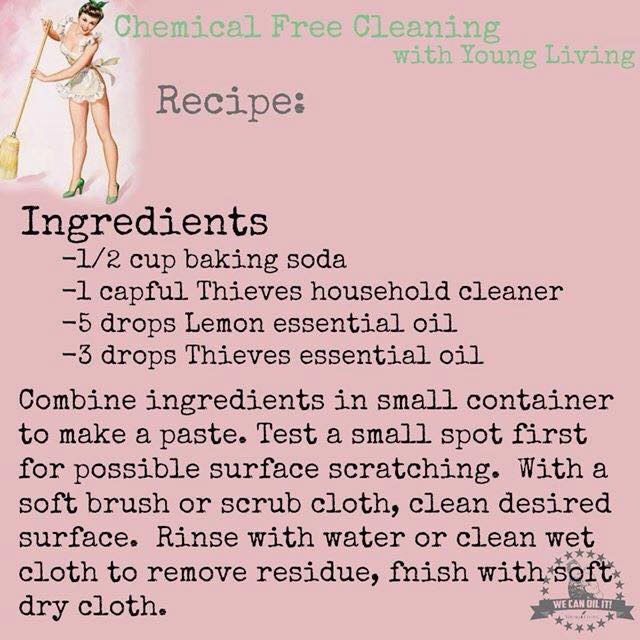
This is for solid surface cleaning. Test first to make sure it doesn't scratch in a small area.
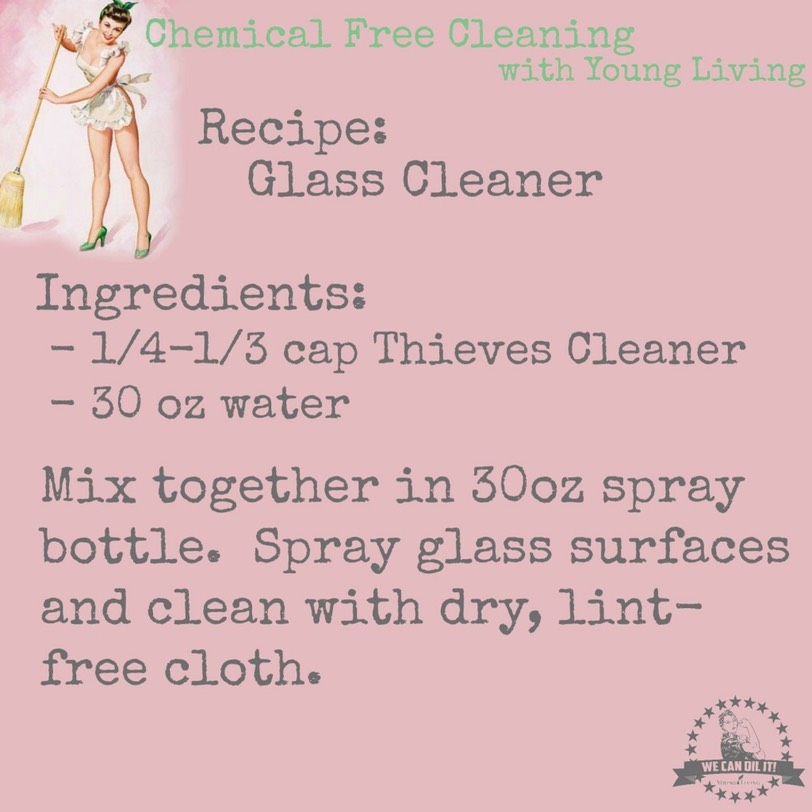
With THIS recipe you need never to have to inhale those strong window cleaner fumes again. And it works too!
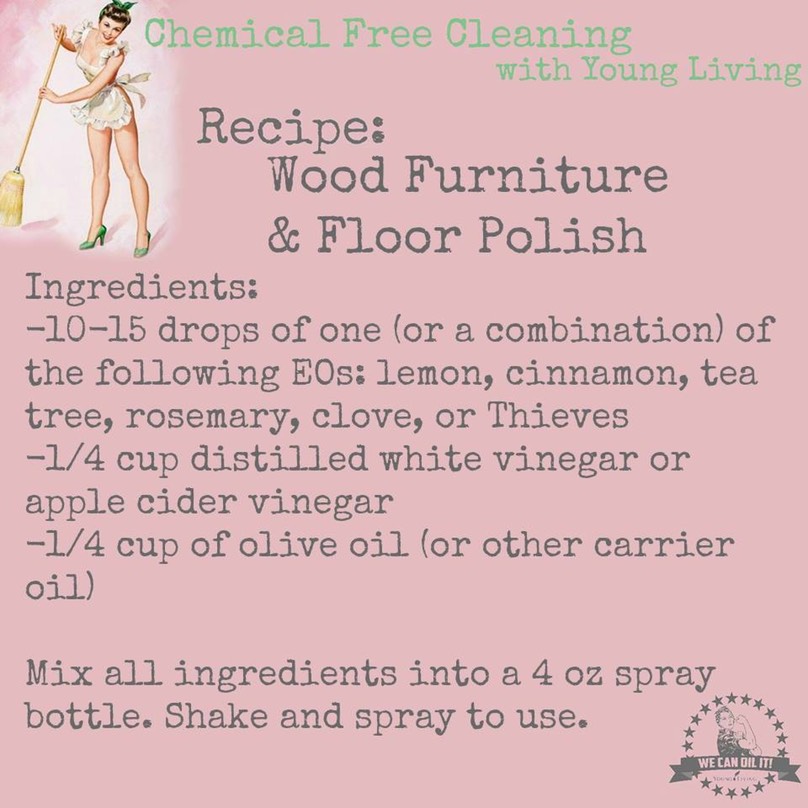
Even your wood polish can get a "clean green" makeover.
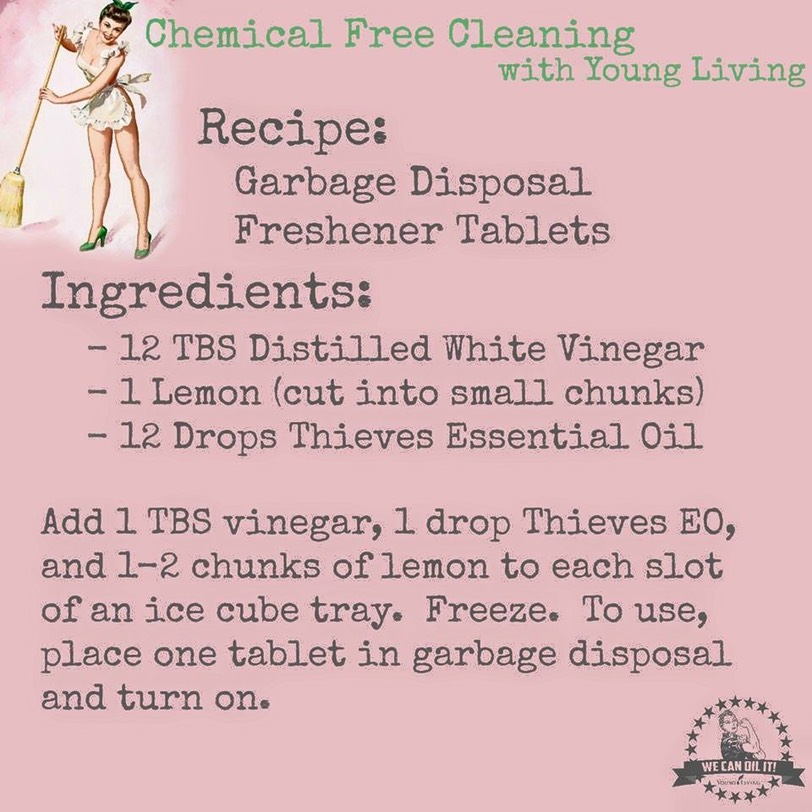
Got a disposal and sometimes it doesn't get turned on often enough to keep the odors down? Thieves and Lemon to the rescue again. (You can use Lemon EO instead of pieces of real lemon. Suit yourself)

Yet another victory for Thieves! The baking soda gives it enough texture to scrub and the Thieves cleans well enough to keep us all happy.
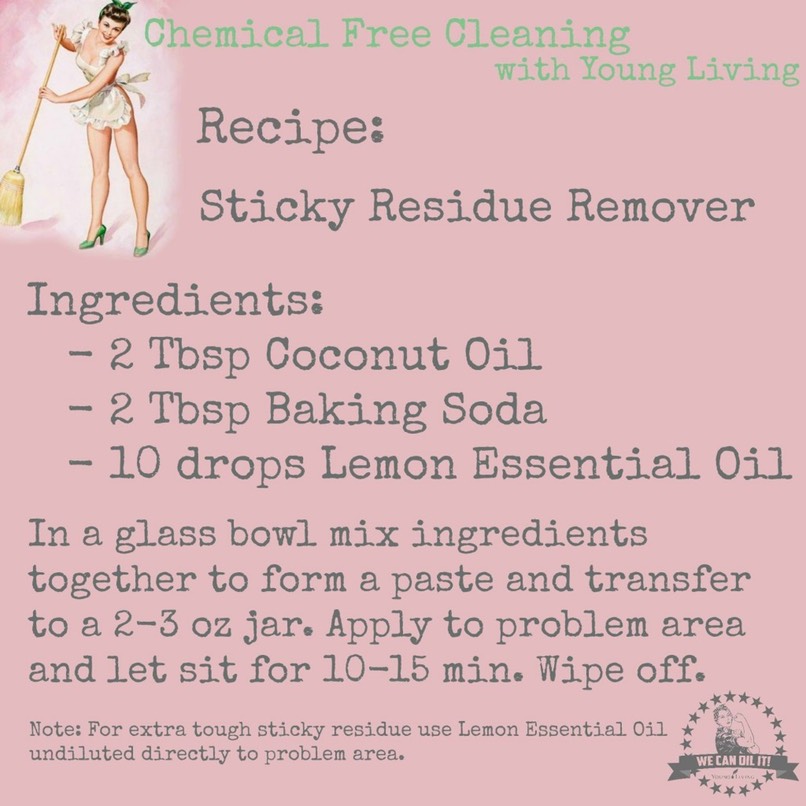
This one I can vouch for! Stickers that won't come off, gum in children's hair, you name it! I have even heard rumors of certain types of markers that this works for if you have budding artists that haven't learned to 'stay in the lines’ yet.
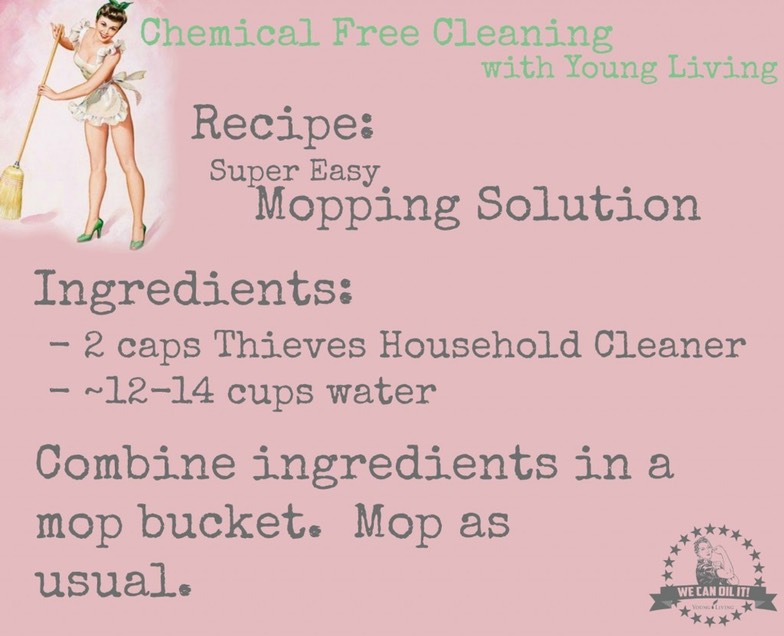
Just for general mopping: You can reduce this recipe for a smaller amount but seriously! Thieves Household cleaner and water in a mop bucket. BOOM!

You are probably thinking about now, so just how much is a 'chemical free lifestyle' going to set me back? Seriously, we don't think twice about buying luxury items from time to time. What is your own health worth? I'm going to show you that chemical free doesn't have to empty your pocketbook in the process.
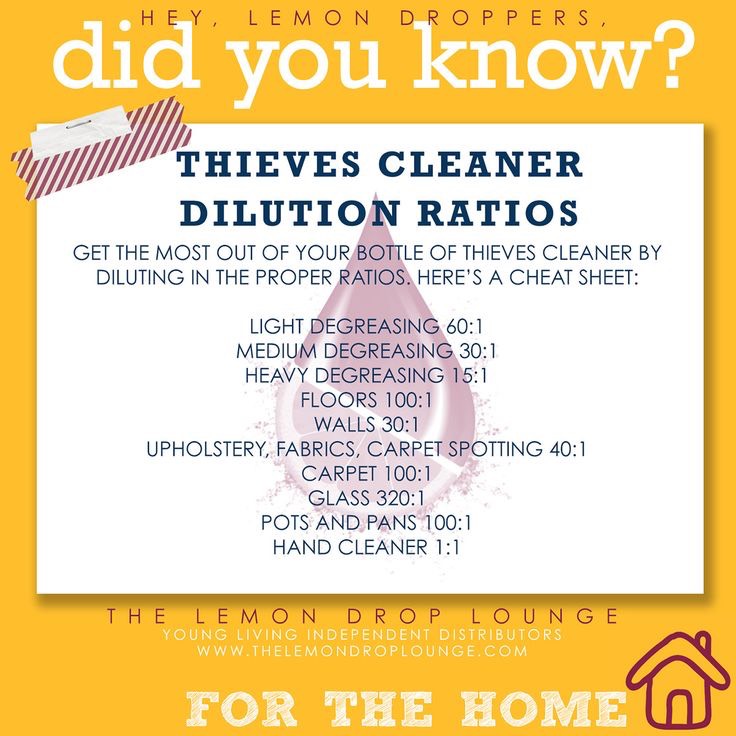
Something fun to use in your clothes dryer also is wool dryer balls. They are especially nice to add a couple of drops of your favorite essential oil and make your clothes smell wonderful! Here is a link to a seller in Etsy where I got mine:
Those hand purifiers either have tons of chemicals OR alcohol which burns and is very drying. I now carry the Thieves Waterless Hand Purifier around with me everywhere I go! The small ones fit in a pocketbook or in your car console, I keep them in my office too! Now, I also like buying the large one with the pump to refill the smaller bottles.
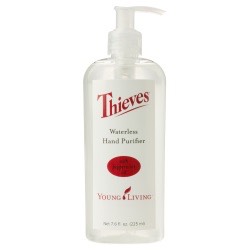
If you would like to check out the cosmetics and personal toiletry items you are currently using, I found an app that will scan the barcode (or you can look up the chemicals individually) to see how they are rated. I had to throw a bunch of mine away when I learned they were a "9" out of "10" in the carcinogenic scale! The app is called "Think Dirty" and you can click on the link to download it yourself.
And one last thing.....the water you drink is basic to good health. Recent reports have shown us that SO MANY CHEMICALS are being left in our water supply (and a few bad ones are also being added!). Pharmaceuticals like birth control and other medications are in our water supply. Our family started using a drip type filter that gets it all, even the fluoride. The one we use is the Berkley. Our water tastes awesome and I am happy that I know we are removing harmful chemicals from our water supply.
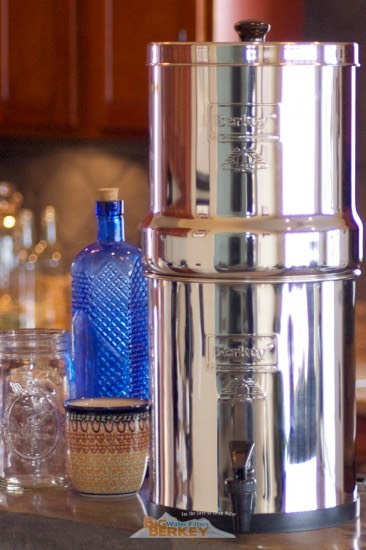
I hope you have enjoyed this information! It was very convicting just to study it myself and I had to make some changes too! If I can answer any questions you have, please don't hesitate to ask.